

How to Write a Tour Guide Script Perfectly in 2024 (Craft Engaging Narratives!)
- Blog , Digital Nomad Travel Guide
- January 2, 2024

To write a tour guide script, identify key attractions, and weave in engaging stories. Highlight facts that captivate and entertain your audience, keeping them intrigued throughout the tour.
How to Write a Tour Guide Script perfectly? A tour guide script is the backbone of any memorable and educational guided tour. Crafting a script requires a balance of historical data, interesting anecdotes, and practical information. It should be engaging, offering unique insights that intrigue your audience and provide a deeper connection to the sights.
A successful tour guide script is not just a monologue but a conversational tool to interact with your audience and enhance their touring experience. It’s crucial to tailor your content to your specific audience, ensuring clarity and relevance. The goal is to leave your tour-goers with lasting impressions and newfound knowledge about the places they’re exploring. Remember, a well-crafted script is the key to making any trip both enjoyable and informative.
KEY TAKEAWAYS
- Engage Your Audience from the Start: The importance of a compelling opening hook was emphasized. Drawing in your audience from the very beginning is crucial to capture their attention and set the tone for an engaging tour. This could involve a fascinating fact, a thought-provoking question, or a captivating anecdote related to the tour destination.
- Blend Information with Storytelling: From early on, try how to effectively weave information seamlessly into storytelling. Rather than presenting a dry list of facts, the recommendation is to integrate historical details, anecdotes, and intriguing facts into a cohesive narrative. This approach not only educates the audience but also entertains and keeps them enthralled throughout the tour.
- Encourage Reflection and Interaction: Incorporate moments for reflection and audience interaction throughout the tour. Pose thought-provoking questions and invite participants to engage actively with the content. This not only enhances the educational aspect of the tour but also fosters a dynamic and participatory experience. Such an approach allows tour attendees to connect more deeply with the subject matter, making the entire tour more memorable and enjoyable.
Table of Contents
What Is A Tour Guide Script?
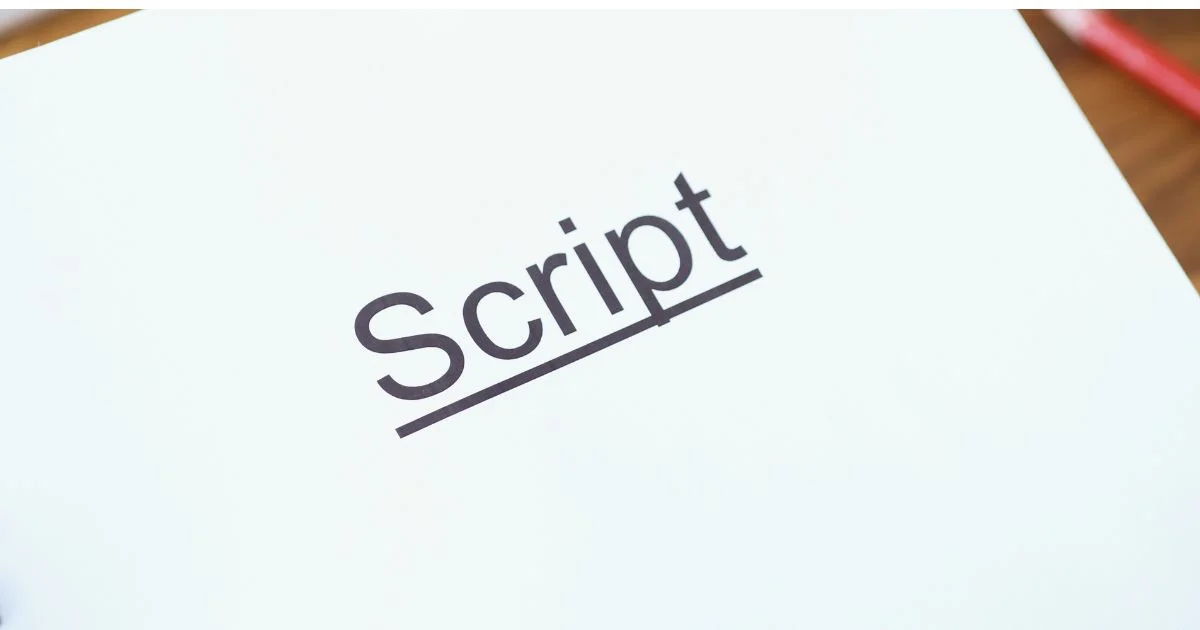
Embarking on an unforgettable journey requires more than just a keen sense of direction; it demands a captivating narrative to guide the way. A tour guide script plays a pivotal role by being the very crux of this narrative, paving the path for explorers through a blend of storytelling and factual information.
Tour guide scripts are meticulously crafted pieces of writing designed to enrich the touring experience for guests. They serve multiple purposes:
- Instructional roadmap: It outlines the tour’s structure, guiding the guide through each segment and transition smoothly.
- Engaging storytelling tool: The script contains fascinating tales and anecdotes about the places visited, ensuring an engaging and memorable experience.
- Educational resource: By delving into historical, cultural, or natural insights, the script educates and informs the audience.
- Interpersonal connector: It prompts interaction with the audience, encouraging questions and discussions.
A well-composed script transforms a mundane outing into an educational adventure, leaving tourists with lasting memories and insights into the visited landmarks. Consider a tour guide script as the backbone of the tour, supporting a seamless integration of fun facts, navigation, and interaction that all contribute to a successful and spellbinding tour.
Tour Guide Script Opening Remarks

Crafting A Captivating Beginning For Tour Guide Scripts
Crafting the perfect opening remarks for a tour guide script is akin to setting the stage for an enthralling performance. The initial words that emerge from the guide’s mouth can either spark the audience’s interest or fail to captivate them.
Therefore, it’s critical to start strong with remarks that are both welcoming and hint at the exciting journey ahead.
Incorporate Local Greetings
Starting a script with a touch of local flavor can immediately draw your audience in and show cultural immersion:
- Local greeting: Use a common greeting from the tour’s area to create a sense of place.
- Acknowledge return visitors: Express pleasure for repeat guests, signaling that the experience is worth revisiting.
Share An Intriguing Fact Or Story
Kicking things off with an interesting tidbit can pique curiosity and set the tone for the tour:
- Share a secret: Begin with an unknown or little-known fact about the location to entice your audience.
- Tell a short story: Relay a brief anecdote that ties into the tour’s theme or destination, providing a narrative hook for listeners to latch onto.
Outline Expectations Clearly
It’s essential to manage your audience’s expectations from the get-go for a smoother experience:
- Duration of the tour: Clearly stating the tour length helps guests gauge their time commitment.
- Key attractions: Preview some highlights to build anticipation for the sights and experiences on the itinerary.
Emphasize Engagement And Interaction
Encourage your guests to interact and engage with the tour, ensuring a memorable and dynamic experience:
- Promote questions: Invite the crowd to ask questions at any time, fostering a two-way dialogue.
- Suggest participation: Let guests know their involvement is not only allowed but encouraged, whether it’s trying something hands-on or sharing their insights.
Communicate Essential Safety Information
Safety must always be a priority, so make sure your audience knows what to do in case of an emergency:
- Point out safety features: Briefly note the location of exits, first-aid kits, or life vests.
- Cover basic safety rules: Include any necessary guidelines applicable to the tour to prevent accidents and ensure collective well-being.
By incorporating these elements into your opening remarks, you set the stage for an informative, enjoyable, and smoothly run tour that will keep your audience captivated from start to finish. Remember, the goal is to blend education with entertainment seamlessly—forge a connection, earn trust, and most importantly, leave your guests eager for the adventures that lie ahead.
Become A Confident Public Speaker

1. Embrace Your Unique Voice
As a tour guide, your voice is your most valuable asset. Projecting confidence begins with accepting and leveraging the unique qualities that make you stand out. Embrace your tone, cadence, and accent, as these are part of what makes each tour distinctly yours.
2. Practice Makes Perfect
The path to public speaking confidence is paved with practice. Regularly rehearsing your script aloud will:
- Improve diction: Speaking is vital for keeping your audience engaged.
- Assist with pacing: The flow of your speech affects the audience’s ability to absorb information.
- Build familiarity: The more you rehearse, the more natural the content will feel, reducing the need for constant script-checking.
3. Engage With Your Audience
Creating a connection with your audience can transform your script from monologue to dialogue:
- Eye contact: This establishes a personal connection and can help gauge the audience’s interest and understanding.
- Responsiveness: Adapt to audience reactions and questions to make the experience more interactive.
4. Incorporate Storytelling Techniques
Storytelling can elevate a factual guide into an enthralling narrative:
- Set the scene: Paint a vivid picture of each location to immerse your audience fully.
- Use anecdotes: Personal or historical stories related to the tour sites can make the information more relatable and memorable.
5. Maintain Positive Body Language
Confidence is as much about what you say as how you say it:
- Posture: Standing tall conveys authority and can positively affect your vocal projection.
- Gestures: Appropriate hand movements can emphasize points and make your delivery more dynamic.
6. Continue Learning
As with any skill, staying informed and educated is crucial for growth:
- Stay updated on public speaking techniques: New methods can revitalize your approach and effectiveness.
- Learn from others: Attend other tours to observe different styles and incorporate elements that resonate with you.
By following these practical steps and consistently honing your public-speaking prowess, your tour guide scripts will not only inform but also delight and inspire your audience, leaving a lasting impression long after the tour ends.
How To Make A Good Commentary In Tour Guiding?

Below, let’s explore how to create a commentary that transforms a simple excursion into a memorable adventure.
Understand Your Audience
Before diving into scriptwriting, take a moment to think about your audience. Are they history buffs, adventure seekers, families with children, or a mix of everyone? A good commentary should cater to the interests of your group:
- Audience analysis: Identify the demographics, interests, and knowledge level of your tour group.
- Tailoring content: Adjust your script to include information that resonates with these interests.
- Engage personally: Add personal touches or address the group in a way that makes them feel included in the narration.
Keep It Relevant And Accurate
Your script should be a treasure trove of facts and anecdotes that pertain to the locations you are touring. Here’s how you can make it educational and entertaining:
- Reliability: Double-check all historical facts, dates, and figures to establish credibility.
- Relevance: Connect your commentary to the location’s significance or events that capture the essence of the place.
- Anecdotes: Include short stories or interesting tidbits that stick with the audience and enrich the experience.
Mix Humor With Information
A great tour guide script delicately balances educational content with a light-hearted tone. The incorporation of humor makes the tour more enjoyable and less monotonous:
- Light humor: Introduce jokes or funny observations that relate to the sightseeing points without overshadowing the informational content.
- Timing: Know when to use humor effectively, especially after a heavy dose of history or facts to lighten the mood.
Utilize Storytelling Techniques
Weaving a story around the facts makes the commentary not just informative but memorable. This technique allows you to connect with the tour group on an emotional level, guiding them through a historical or cultural journey:
- Chronological flow: Arrange events or information in a logical sequence to maintain clarity.
- Vivid descriptions: Paint a picture with words to make locations come alive in the imagination of your listeners.
Engage With Interactive Elements
It’s not just about what you say, it’s also about how you encourage participation:
- Questions: Ask open-ended questions that provoke thought and encourage interaction.
- Activities: Include pauses where attendees can engage with the environment or participate in brief activities related to the tour.
Plan For The Unexpected
Tours don’t always go according to plan. Here’s how you can stay ahead:
- Flexibility: Have additional material or alternative routes ready in case of unforeseen circumstances.
- Problem-solving: Be prepared to smoothly transition your script to adapt to changes.
Remember, every word and phrase in your script weaves a larger picture, setting the stage for an unforgettable journey. Embrace these strategies, and you’ll be well on your way to crafting a tour guide commentary that is as engaging as it is informative.
Researching The Destination
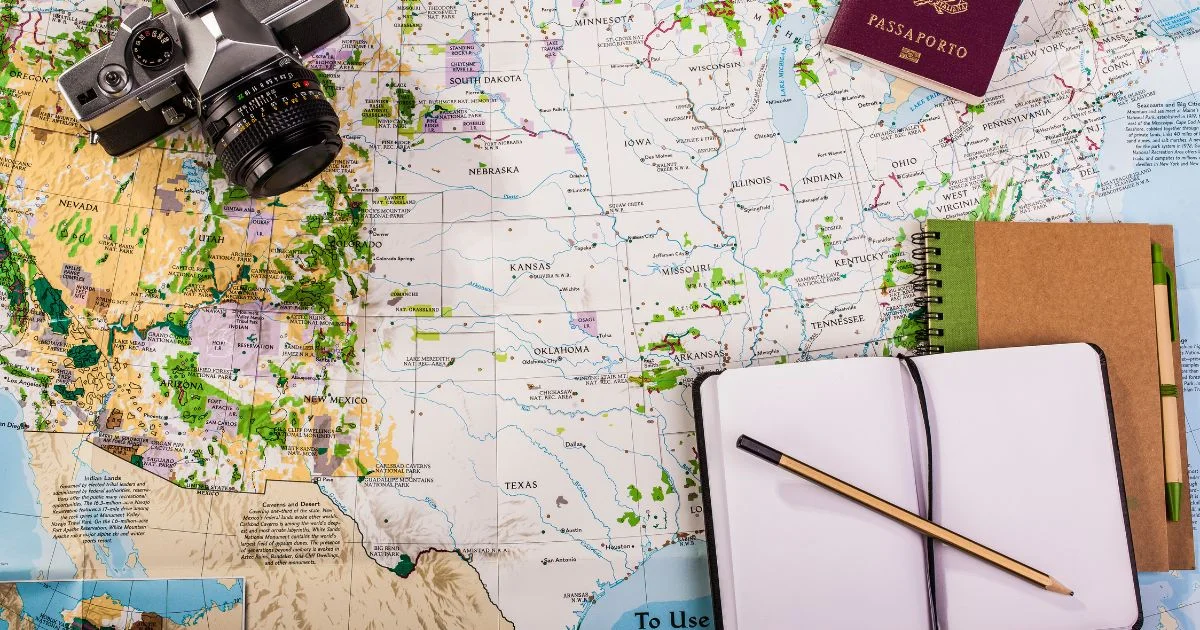
Understand The Historical Context
The true essence of a place is often rooted in its history. Embarking on a journey through a destination’s past can provide invaluable insights for a compelling tour guide script:
- Research the founding dates and key events: This lays a historical timeline for your narrative.
- Identify significant figures: Historical personalities can add vividness to your storytelling.
- Explore local myths and legends: These can captivate and intrigue your audience, adding a mystical layer to the factual history.
Delve Into Current Cultural Practices
To paint a complete picture, it’s crucial to intertwine the past with the present. Tourists are often just as interested in current customs as they are in ancient tales.
- Investigate local festivals and events: Knowing local celebrations can descriptively showcase the community’s spirit.
- Understand dietary customs: Food is a profound reflection of cultural identity and can be a savory detail in your script.
- Recognize contemporary art and music: These elements underscore the modern vibe of a place, connecting the past to the present.
Highlight Noteworthy Landmarks
Tourists are visually oriented, seeking the spectacular sites that give a place its postcard-worthy status. Dive into the architectural wonders and natural sceneries that define your location. This is where you can turn descriptions into experiences, invoking the grandeur of man-made edifices or the serene whisper of a rolling landscape.
Gather Local Stories And Anecdotes
A place’s heartbeat is often felt in the stories of its inhabitants. Collecting anecdotes can give your script a personable touch that aligns perfectly with the sightseeing experience:
- Talk to residents: Their personal experiences can provide unique and engaging content for your script.
- Read local literature: Novels, poems, and articles can offer a treasure trove of inspiration and authentic material for your narrative.
- Follow community social media groups: They can be goldmines for the latest buzz and little-known facts about your destination.
In weaving together your research, ensure that your script resonates with the enthusiastic pulse of eager explorers. Let your words be their guide through time, culture, and the marvels of the destination; transforming each step into a discovery and each view into a lasting memory.
Understanding The Target Audience

Identifying Demographics
Demographics provide insight into the age, nationality, and cultural background of your audience:
- Age range: This influences the complexity of language and the choice of stories.
- Nationality: Being aware of where your audience comes from can help you include relevant cultural references or explain local customs in a relatable way.
- Cultural interests: Understanding whether your audience prefers art, architecture, history, or nature helps tailor the content of your tour.
Through this understanding, you can shape a script that resonates with your audience, making your tour not only informative but also deeply engaging.
Recognizing The Visitor’s Purpose
People take tours for various reasons. Identifying these can vastly improve the script’s relevance:
- Educational objective: Is the tour part of a study trip? Incorporate more detailed historical data and analysis.
- Leisure and relaxation: For those seeking enjoyment, prioritize captivating stories and lighter, entertaining content.
- Specialized interest: Cater to enthusiasts by delving into niche topics such as local gastronomy or architectural styles.
Assessing Prior Knowledge
Being mindful of the audience’s existing familiarity with the toured area contributes to a well-paced and informative experience:
- First-time visitors: Explain the context and basic information more thoroughly.
- Repeat visitors: Focus on lesser-known facts or unique perspectives that deepen their understanding.
Remember, the best tour guide script is one where the audience feels seen, understood, and considered throughout the journey. This way, you create not just a tour, but a memorable adventure for every participant.
Structuring The Script For Maximum Impact

Let’s delve into how you can structure your script to achieve a seamless storytelling experience in 6 easy steps:
1. Beginning With A Bang
Starting strong sets the tone for the rest of your tour. Your opening remarks should be:
- Compelling: Draw in your audience with an intriguing fact or question.
- Relevant: Ensure it relates to the theme and purpose of the tour.
- Brief: Keep it concise to maintain interest and curiosity.
2. Dividing Your Content
Your tour script should flow naturally from one segment to the next, like chapters in a book. To accomplish this:
- Organize logically: Arrange points in an order that makes sense geographically or thematically.
- Pace evenly: Divide content so that each part is given appropriate time.
- Transition smoothly: Use connecting sentences to seamlessly move from one point to another.
3. Emphasizing Key Points
Within the body of your script, highlight the must-know details:
- Significance: Explain why certain facts or sites are noteworthy.
- Clarity: Present information clearly and avoid jargon that may confuse visitors.
- Engagement: Pose questions or invite participation to keep the audience involved.
4. Wrapping Up With A Memorable Close
Conclude your script on a high note by ensuring:
- Reflection: Encourage the audience to think back on the experience.
- Summary: Recap the key themes or highlights of the tour.
- Call to action: Suggest further reading, places to visit, or encourage feedback.
5. Pacing Your Information Delivery For Audience Retention
A well-paced script is the key to keeping your audience engaged throughout the tour. Overloading listeners with information can lead to disconnect, while too little may cause them to lose interest. Think of your script as a symphony with variations in tempo . Arrange your content to alternate between storytelling, facts, and pauses, where the audience can absorb the sights and sounds around them.
- Introduce a captivating story.
- Follow with intriguing facts or history.
- Pause to allow reflection and observation.
- Resume with anecdotes or lesser-known tidbits.
- Encourage questions and discussions.
6. Incorporating Interactive Elements Into Your Narrative
Interactivity transforms a monologue into a dialogue, fostering a more dynamic and memorable experience. Consider incorporating interactive elements such as Q&A sessions , scavenger hunts , or role-playing activities to immerse your audience in the narrative. A simple, “Can anyone guess the reason behind this building’s unusual shape?” can spur participation and investment in the tour’s storyline.
Crafting an effective tour guide script requires thoughtfulness in structure and content. Through the careful organization of your script, punctuated with engaging and significant facts, you’re setting the stage for an unforgettable experience for your audience. Keep it concise, keep it lively, and watch as your words bring the life journey.
Writing Techniques You Can Follow for Maximizing Output

Paint Pictures With Words
- Vivid descriptions: Bring locations to life with descriptive language that appeals to the senses. Imagine you’re creating a scene in a novel.
- Storytelling: Weave historical facts with anecdotes to captivate your listeners. A personal touch can make history feel relevant and intriguing.
Incorporate Interactive Elements
Tour experiences become more enriching when the audience is involved. Utilize these techniques:
- Questions to ponder: Pose thought-provoking questions that encourage reflection on the visited sites.
- Activities: Brief, relevant activities can break up the script and maintain engagement. For example, asking the group to imagine themselves in a historical moment.
Keep It Structured
Every word counts in a script where attention spans are limited. Organize your content to ensure clarity and logical flow. Highlight the key points you want the audience to take away, and transition smoothly between topics to keep the narrative engaging.
Use Humor Wisely
- Relatability: Humor helps connect with the audience, but it’s crucial to be sensitive to cultural differences.
- Timing: Strategic placement of light-hearted comments can enhance enjoyment but be aware of the context in which you use them.
Precision And Brevity
Keeping it Precise and Concise is vital. Here are some of the ways you can do that:
- Stay on topic: Avoid meandering narratives that can cause a loss of interest.
- Simple language: Opt for direct, straightforward sentences that are easy to follow while walking and absorbing the surroundings.
Remember, your script is the bridge between the audience and the world you’re describing. It is both an educational tool and an entertainment source. Keep your voice natural, as if you’re conversing with a friend, for a truly immersive experience.
Closing Tour Guide Script

Engage With A Personal Touch
- Thank you for joining us:
Express genuine gratitude toward your audience for choosing your tour and spending their time with you.
- Share a personal story or favorite moment:
Conclude with an anecdote that ties back to the journey, reinforcing a personal connection and making the closing remarks more relatable.
Encourage Further Exploration
- Suggest related places of interest:
Recommend nearby attractions or hidden gems that guests could explore on their own to continue their adventure.
- Offer materials for additional information:
Provide pamphlets, website links, or social media handles that direct guests to more resources about the sights they’ve seen.
Seal It With A Call To Action
Creating an effective call to action can help maintain the connection between you and your guests long after the tour ends. Encourage them to share their experience through social media, write a review, or sign up for future tours. This not only promotes your service but also fosters a community of enthusiastic travelers.
Parting Words Of Thanks
- Reiterate your thanks:
A final thank you reaffirms the value you place on your guests’ choice to spend their day with you.
- Wish them well on their journey:
Send them off with warm wishes for the rest of their travels, highlighting your role as both a guide and a goodwill ambassador.
As your group prepares to disperse, remind them of the incredible journey you’ve shared, and let them know that their presence made the tour that much more special. With these tips in mind, your closing script will not only echo in their memories but will encourage them to dive deeper into the wonders they’ve just discovered.
Practical Tips for Writing A Perfect Tour Guide Script

1. Research Thoroughly
Immersing your listeners in the experience requires more than just skimming the surface:
- Historical accuracy: Ensure every historical reference is double-checked for accuracy to build trust with your audience.
- Local color: Dig for those quirky facts and lesser-known stories that give a place its unique flavor and charm.
2. Keep It Interactive
Avoid monologues; encourage participation to keep your audience engaged:
- Questions and prompts: Spark curiosity by asking questions or encouraging them to guess what’s next.
- Physical involvement: Allow them to touch, feel, or perform actions when appropriate to create a multisensory experience.
3. Balance Information With Entertainment
A good tour guide script educates while it entertains; here’s how to strike that balance:
- A mix of facts and stories: Blend historical accounts with anecdotes to keep the information digestible and exciting.
- Humor: A dash of light-heartedness can make a tour memorable but use it judiciously according to your audience’s tastes.
4. Script Structure Is Key
An organized script ensures a smooth tour flow:
- Chronological order: If possible, structure your narrative to follow a logical timeline that’s easy to follow.
- Clear transitions: Guide your group from one topic to the next with smooth segues to maintain continuity and interest.
5. Practice Pacing
The rhythm of your delivery can have a significant impact:
- Variety in tone: Use changes in pitch and pace to highlight different points, creating a dynamic audio experience.
- Pauses: Employ short pauses to let important information sink in or to build suspense before revealing an interesting fact.
6. Language And Word Choice
Selecting the right words can paint a vivid picture:
- Descriptive language: Enliven your script with descriptive language that helps your audience visualize the scene.
- Simple terminology: Choose words that are easily understandable to avoid alienating listeners who may not be familiar with complex jargon.
7. Understand Your Audience
Take a moment to consider who will be listening to your script:
- Audience demographics: Tailor your language and content to the age, interests, and cultural background of your audience.
- Audience knowledge: Gauge their familiarity with the subject to provide information that enlightens, but doesn’t overwhelm or bore.
8. Final Touches
Before the premiere of your tour, some finishing touches are needed:
- Rehearse out loud: This can help you catch any tongue-twisters or awkward phrasing.
- Seek feedback: Share your script with a trusted colleague or friend to get a fresh perspective and constructive criticism.
By following these practical tips, you will craft a tour guide script that not just informs, but also inspires and entertains. Remember that the most extraordinary tours are those where the guide’s passion for the subject shines through every word.
Example Of A Tour Guide Script

Good day, intrepid explorers! Welcome to the land where history whispers through the winds and the sands tell tales of ancient wonders. I’m [Your Name], your guide on this extraordinary journey, as we stand in the shadow of a marvel that has withstood the test of time – the Great Pyramid of Giza!
As we gather here today, envision a time when pharaohs ruled and colossal monuments rose from Egyptian soil. The Great Pyramid, also known as the Pyramid of Khufu, stands as a testament to the ingenuity of the ancient Egyptians. But let’s not get ahead of ourselves. Before we dive into the wonders of this colossal structure, let’s take a moment to soak in the atmosphere and appreciate the magnitude of what lies before us.
[Cultural Introduction]
Let’s start with a local greeting, “Ahlan wa sahlan!” (Welcome!) Egypt, a land where the past and present coexist harmoniously, beckons you to explore its mysteries. And what better way to embark on this adventure than by unraveling the enigma of the Great Pyramid?
Now, my fellow adventurers, how many of you have ever dreamt of standing in front of this colossal structure, pondering the secrets it guards? Today, your dreams become reality as we delve into the heart of ancient Egypt, a civilization that left an indelible mark on the annals of human history.
[History Unveiled]
Our story begins over 4,500 years ago, in the Fourth Dynasty of the Old Kingdom, with the Pharaoh Khufu. Imagine, if you will, a bustling construction site where thousands of laborers, skilled craftsmen, and architects collaborated to build what would become one of the Seven Wonders of the Ancient World.
Now, why did they embark on this colossal project? Was it merely a display of power, or did it hold a more profound purpose? The Great Pyramid was not just a tomb for Pharaoh Khufu but a celestial pathway to the afterlife, a testament to the ancient Egyptians’ belief in the divine journey beyond the earthly realm.
As we stand here, let your imagination wander back to the time when the Great Pyramid gleamed, covered in smooth, white Tura limestone casing stones, reflecting the sun’s brilliance like a dazzling jewel against the golden Egyptian sky.
[Intriguing Facts]
Let’s sprinkle our journey with some fascinating facts about this architectural marvel. Did you know that the Great Pyramid was originally 146.6 meters tall but has slightly diminished over time? Even so, its towering presence remains awe-inspiring, standing as the tallest of the original Seven Wonders of the World.
Consider this – the Great Pyramid was constructed with an estimated 2.3 million blocks of limestone and granite, each weighing several tons. How on earth did the ancient Egyptians transport and position these colossal stones with such precision? That, my friends, is a question that still intrigues archaeologists and Egyptologists today.
And here’s a little puzzle for you: Can you guess how many chambers are concealed within the heart of the pyramid? Well, not to keep you in suspense – there are three primary chambers: the King’s Chamber, the Queen’s Chamber, and an underground chamber. Each holds its secrets, and we’ll explore them in due course.
[Questions and Reflection]
Now, let’s pause for a moment of reflection. Imagine you’re an ancient Egyptian gazing upon the Great Pyramid for the first time. What thoughts might be swirling in your mind? How would the sheer magnitude of this structure inspire awe and wonder?
Consider the symbolism embedded in every block, the meticulous alignment with the cardinal points of the compass, and the reverence for celestial bodies. As you ponder these questions, you start to grasp the layers of meaning woven into the very fabric of this monumental creation.
[Exploring the Chambers]
Our journey continues as we venture inside the Great Pyramid, stepping into the sacred spaces that have guarded the mysteries of millennia. As we enter the grand gallery leading to the King’s Chamber, imagine the echoing footsteps of priests, the flickering light of torches, and the anticipation of reaching the heart of the pyramid.
The King’s Chamber, with its granite sarcophagus, sparks countless debates among scholars. Was it truly the final resting place of Pharaoh Khufu, or does it conceal a deeper cosmic significance? Take a moment to absorb the resonance of this sacred space, where ancient rituals and ceremonies unfolded.
[Anecdotes and Mysteries]
Let me share a captivating anecdote about the Great Pyramid. Legend has it that when the Arab conqueror Al-Ma’mun opened the pyramid in the 9th century, he discovered an astonishing sight – a massive, starry-eyed, mummy-like figure sitting on a throne. This figure, known as the “Doomsday Machine,” was believed to come to life when the end of the world approached. A fantastical tale, indeed, but one that adds an intriguing layer to the mystique of the Great Pyramid.
As we navigate through the Queen’s Chamber and the subterranean chamber, let your senses absorb the energy that permeates these ancient corridors. These chambers, with their unique features and alignments, deepen the enigma surrounding the purpose of the Great Pyramid.
[Connecting With the Cosmos]
Now, let’s delve into the astronomical alignment of the Great Pyramid. The four sides of the pyramid are remarkably aligned with the cardinal points of the compass – north, south, east, and west. The precision with which the ancient Egyptians achieved this alignment is nothing short of astronomical genius.
Consider the correlation between the sides of the pyramid and the cardinal points as a celestial dance, connecting the earthly realm with the cosmos. The Great Pyramid, in its harmonious alignment, served as a symbolic bridge between the earthly kingdom of Pharaoh Khufu and the celestial realm of the gods.
[Legacy and Influence]
As we conclude our exploration, let’s reflect on the enduring legacy of the Great Pyramid. This iconic structure has not only withstood the ravages of time but has inspired generations of explorers, scholars, and dreamers.
The architectural principles and mathematical precision demonstrated in the construction of the Great Pyramid continue to captivate modern minds. Its influence extends beyond the boundaries of ancient Egypt, reaching into the realms of architecture, mathematics, and even mysticism.
As we stand here, surrounded by the whispers of antiquity, let the Great Pyramid of Giza be a beacon that transcends time. It beckons us to ponder the mysteries of the past, marvel at the achievements of our ancestors, and contemplate the intricate tapestry of human history.
I hope this journey has ignited a spark of curiosity within each of you, a curiosity that will linger long after we part ways. Remember, the Great Pyramid is not merely a monument of stones; it is a gateway to the mysteries of the ages, an invitation to explore the profound connection between humanity and the cosmos.
Ahlan wa sahlan! Thank you for joining me on this unforgettable expedition through the marvels of the Great Pyramid of Giza. May your travels be filled with wonder, and may the echoes of ancient Egypt linger in your hearts forever. Safe travels, fellow adventurers!
Craft Engaging Narratives in Tour Guiding

Understanding Your Audience For Maximum Engagement
Every tour guide knows that the foundation of a successful tour is understanding the audience . A deep comprehension of who the tour attendees are—their interests, cultural background, and what they wish to gain from the experience—can dramatically shape the way a narrative is structured for maximum engagement.
- Analyze the demographics of the group to tailor content that is relevant and interesting.
- Ask preliminary questions or provide a questionnaire beforehand to get insights into your audience’s expectations.
- Adjust your language and delivery style based on the audience’s expertise level or age group to maintain engagement.
The Role Of Storytelling In Enhancing The Tour Experience
Storytelling is not merely a tool for entertainment; it is an essential mechanism for creating a memorable experience. A well-crafted story can make historical facts come alive, build a connection between the audience and the location, and leave guests with a lasting impression.
- Create a theme that ties the narrative together.
- Use vivid descriptions to place the audience in the scene, engaging multiple senses.
- Develop emotional arcs through anecdotes or personal stories related to the sites.
- Integrate interactive elements to encourage participation and keep the group dynamic.
Remember, the aim is to transform a monologue into an interactive dialogue. Engage with compelling narratives that are both informative and enjoyable to leave a mark on your audience’s travel experience.
Content Curation For Making the Script Interactive

Aspiring to excel as a tour guide requires a script that is not only informative but also captivating to your audience. Research and content curation are the foundational elements for a well-crafted script that will leave your guests with lasting memories. Whether you’re wandering through historical landmarks, vibrant city streets, or tranquil nature trails, embedding accurate details and interesting narratives is key to enhancing the tour experience.
To curate engaging and educational content for your tour guide script, you must start with thorough research to gather relevant information. This process ensures that the facts you share are not only accurate but also resonate with your audience. Dive into this essential phase with focus and creativity to transform raw data into a memorable storytelling experience.
Sourcing Accurate And Interesting Facts
Finding reliable and fascinating facts is integral to your tour guide script. The aim is to not only educate but also to intrigue your audience. Start by consulting reputable sources such as:
- Official historical archives
- Local museums and cultural centers
- Books written by respected historians or subject matter experts
- Documentaries and academic journals
- Local experts or oral history interviews
Remember to verify the information from multiple sources to ensure accuracy. Keeping a balance between well-known facts and lesser-known trivia can captivate your listeners and make your tour stand out.
How To Weave Historical Context Into Your Tour Guide Script
Providing historical context helps your audience appreciate the significance of the sights they are seeing. Here are some tips to seamlessly integrate history into your script:
- Start with a brief overview of the area’s history, setting the stage for your tour.
- Use narrative techniques to make historical events come alive, such as storytelling or reenacting scenes.
- Connect historical events to present-day locations or landmarks.
- Include anecdotes about historical figures to personalize the experience.
- Employ descriptive language that helps guests visualize the past.
By crafting each element carefully, you blend education with entertainment, creating a powerful experience that goes beyond mere sightseeing. Engage your audience by making history relevant and relatable, allowing them to step back in time and truly connect with the destination.
Language And Delivery Techniques
Guiding tourists is an art form that blends storytelling, information sharing, and entertainment. The success of a tour often lies in the language and delivery techniques employed by the guide. An impactful script and skillful delivery can transform a mundane excursion into an unforgettable experience. By focusing on tone, language, and rhetorical devices, tour guides can ensure their narratives resonate with diverse audiences and create lasting impressions.
Perfecting Tone And Language For Diverse Audiences
Every audience is unique, and adapting your script to cater to each group’s specific interests and comprehension levels is crucial. Perfecting tone and language demands a keen understanding of cultural sensitivities and preferences. Striking the right chord with your audience is essential for engagement.
- Know Your Audience: Gather as much information as you can about your tour participants to tailor your language and references appropriately.
- Be Inclusive: Use language that is accessible and refrain from jargon that could exclude or confuse listeners.
- Vary Your Tone: Different segments of the tour may call for different tones; a historical account might be solemn, while an anecdote could be light-hearted.
Effective communication goes beyond words. Nonverbal cues, such as body language and facial expressions, play a vital role in conveying emotion and enthusiasm, making your script more relatable and your tour more enjoyable.
Using Rhetorical Devices To Make The Script More Compelling
Employing rhetorical devices can greatly enhance the appeal of your tour script. These techniques are powerful tools that can persuade, entertain, and stir emotions, contributing to a richer, more engaging tour narrative.
Utilizing such a variety of rhetorical tools not only brings your script to life but also helps in creating memorable hooks that tourists are likely to remember and share. Anecdotes, quotations, and dramatic pauses can all contribute to the ebb and flow of the narrative, enticing your audience every step of the way.
Polishing And Practicing Your Script
Perfecting the art of tour guiding encompasses more than just memorizing a script; it’s about delivering a compelling narrative that enchants your audience. As the final draft takes shape, polishing and practicing become crucial in transforming words on a page into a spellbinding experience . Here are essential strategies for refining your script, ensuring your delivery is flawless and captivating .
Tips For Script Revisions And Edits
- Read out loud: Notice any awkward phrasing or tongue twisters.
- Clarity: Simplify complex sentences. Make sure your message is easily understandable.
- Engagement: Include questions or prompts to interact with your audience.
- Pacing: Ensure a natural flow, with pauses for emphasis and reflection.
- Accuracy: Double-check facts, dates, and names. Accuracy builds trust.
- Personality: Let your uniqueness shine through; avoid sounding robotic.
- Feedback: Seek input from peers and consider integrating their suggestions.
How To Tour Guide Script: Rehearse For Perfection
- Memorization: Familiarize yourself with the script to keep eye contact with your audience.
- Voice Modulation: Practice varying your tone to maintain interest and energy.
- Body Language: Use gestures and expressions to enhance the storytelling.
- Mirror Practice: Rehearse before a mirror to observe and improve your presentation.
- Mock Tours: Conduct a few dry runs with friends or family for a realistic experience.
- Location Relevance: If possible, practice on-site to adapt to the environment.
- Time Management: Time your script to fit within the allotted tour duration.
Frequently Asked Questions Of How To Write A Tour Guide Script
A tour guide script is a culmination of well-researched commentary and engaging stories prepared in advance. It serves as a blueprint for tour guides to lead and educate guests about various points of interest throughout a tour.
How Long Should A Tour Script Be?
The length of a tour script often correlates with the duration of the tour itself. Aim for a script that complements the tour’s pace, allowing time for interaction and questions without overloading information, typically several pages for average-length tours.
What Makes A Good Tour Script?
A good tour script is clear, informative, and entertaining, incorporating historical facts with storytelling. It should engage visitors, be easy to follow, and allow space for improvisation, making each tour feel personal and unique.
Can I Write My Own Tour Guide Script?
Creating your tour guide script allows for a personalized touch to the narrative. Ensure it is well-researched, structured, and includes elements of storytelling to captivate your audience effectively.
How Do You Introduce Yourself As A Tour Guide?
Hello, I’m [Your Name], your knowledgeable and friendly tour guide for this adventure! Let’s explore and create memorable experiences together.
How Do You Talk Like A Tour Guide?
Speak with clarity and energy to engage your audience. Use storytelling to make facts come alive. Highlight key attractions with enthusiasm. Stay knowledgeable yet approachable. Keep your script informative, concise, and captivating.
How Do You Write A Travel Script?
Research your topic, craft an engaging introduction, deliver facts with storytelling, maintain a friendly tone, and end with a memorable conclusion.
How do you start a tour guide script?
Start by researching your tour theme and destinations. Outline your main points, ensuring a structured narrative flow. Begin with an engaging introduction, balancing facts with stories. Use short, punchy sentences for clarity. Update your script periodically to keep it fresh and relevant.
Crafting the perfect tour guide script takes practice and skill. Keep your audience engaged with lively descriptions and intriguing facts. Remember to personalize, stay flexible, and infuse your passion into every word. With these tips, your next guided tour is sure to be memorable and captivating for all who embark on the journey with you.
Related posts:
- What are the Disadvantages of Being a Tour Guide? (Unveiling the Challenges)
- Questions to Ask a Tourist Guide To Unlock Hidden Gems While Travelling (2024)
- Best Travel Guide for Ireland in 2024 (Emerald Isle Essentials)
- Is It Better to Travel With a Tour Guide in 2024? (Pros & Insights)
Related Post
Top 10 changes and trends that will shape portugal’s immigration sector in 2024, how much do tour guides get paid in europe (ultimate guide to 2024 salaries), how to get mexico golden visa and passport within 3 months (complete breakdown), how much does nevis trust cost to set up in 2024 (all you need to know), about the author.
Leave a Comment Cancel Reply
Your email address will not be published. Required fields are marked *
Save my name, email, and website in this browser for the next time I comment.

NomadsRoute is your one-stop shop for everything digital nomad lifestyle, residency, citizenship, visa opportunities, and travel guides. We’re here to help you live and work from anywhere in the world, without sacrificing your quality of life or financial security.
- Blog , Golden Visa
- June 10, 2024
How Long Does UAE Golden Visa Application Take in 2024
- Golden Visa
- June 5, 2024
How to Apply for UAE Golden Visa for Engineers in 2024
- May 30, 2024
How Much Does it Cost for Golden Visa in UAE 2024
How to write a review for a tour guide?

Introduction to Writing Reviews for Tour Guides
Imagine you’ve just returned from an unforgettable trip , thanks to a phenomenal tour guide who managed to make every moment memorable. Writing a review for them is not just a way to express your gratitude, but it also helps other travelers make informed decisions. But how do you put your experience into words? How do you convey the essence of your journey to someone who wasn’t there? That’s where the art of writing comprehensive reviews comes in.
Writing a review for a tour guide is not about merely praising or criticizing. It’s about giving detailed feedback, outlining the pros and cons, and providing useful information to future travelers. It’s about sharing your travel experiences in a way that is both informative and engaging.
In this article, you will learn how to write a comprehensive and well-structured review for your tour guide. From understanding the importance of writing reviews to knowing what elements to include, this guide will take you through everything step by step. With these insights, you’ll be able to craft a review that paints a vivid picture of your travel experience.
Get the most out of your stay by booking a Rio de Janeiro private tour when visiting Brazil.
Why Writing a Comprehensive Tour Guide Review Matters
Before learning how to write a review, it’s important to understand why writing a comprehensive tour guide review matters. The first and foremost reason is that it helps future travelers. Your review offers them a glimpse into what they can expect from a particular tour guide and helps them make informed decisions.
In addition, your review also assists the tour guide. Constructive feedback can help them improve their services, and positive reviews can boost their business. This is particularly important for freelance guides or those working with small tour companies, where every review can make a significant difference.
Lastly, writing comprehensive tour guide reviews contributes to the overall travel community. It promotes transparency and honesty, and encourages high standards of service within the travel industry. Your review, therefore, has the power to influence not just individual experiences, but the industry as a whole.
How to Start Your Tour Guide Review
Now that you understand the importance of writing a review, let’s delve into how to start your tour guide review. The beginning of your review sets the tone for the rest of your writing, so it’s important to kick off with a bang. Start by providing an overview of your overall experience. Was it exceptional, good, average, or below average?
Following the introduction, briefly describe the tour. Mention the destination, the duration, and the main attractions covered. This gives readers a context to understand the rest of your review.
The next step is to introduce your tour guide. Write about their personality, their style of guiding, and the first impression they made. A good introduction is crucial as it piques the reader’s interest and encourages them to read further.
Key Elements to Include in Your Tour Guide Review
The body of your review should contain key elements that provide a comprehensive understanding of your experience. Start with the guide’s knowledge and expertise. Did they know the area well? Were they able to answer your questions satisfactorily?
Next, discuss the guide’s communication skills. Were they clear and articulate, or did you struggle to understand them? Also, consider their interpersonal skills. Did they interact well with the group? Did they handle any issues or conflicts effectively?
Lastly, talk about the tour’s organization and logistics. Was the tour well planned? Were there any hitches? By covering these key elements, you provide future travelers with a well-rounded understanding of what to expect from the tour guide.
Step-by-Step Guide on How to Write a Review for a Tour Guide
Writing a review may seem daunting, but by following a step-by-step guide, it becomes a much simpler task. Start by jotting down your initial thoughts and feelings about the tour. This helps you capture the essence of your experience.
Next, organize these thoughts into the key elements discussed in the previous section. Once you’ve done this, start elaborating on each point, providing as much detail as possible.
After you’ve fleshed out your thoughts, it’s time to start writing. Begin with a catchy introduction, followed by a detailed body, and conclude with your final thoughts and overall rating. Remember to be honest, detailed, and balanced in your review.
Tips for Writing an Impactful Tour Guide Review
To write an impactful tour guide review, it’s essential to keep your readers in mind. Use a clear and friendly tone that’s easy to understand. Make your review engaging by including anecdotes or interesting facts from your tour.
Be honest and balanced in your review. While it’s important to highlight the positive aspects, don’t shy away from mentioning areas that need improvement. However, be constructive and respectful in your criticism.
Lastly, proofread your review before posting it. Correct any grammatical errors and make sure that your review is coherent and easy to read. A well-written review not only impacts the reader’s decision but also reflects positively on you as a reviewer.
Examples of Well-Written Tour Guide Reviews
To give you a better understanding, here are a couple of examples of well-written tour guide reviews. Notice how they provide a clear picture of the experience, covering all key aspects like the guide’s knowledge, communication skills, and the organization of the tour.
“Our tour guide, John, was simply fantastic. He was knowledgeable and passionate about the city’s history. He answered all our questions with patience and added interesting anecdotes that brought the tour to life. The tour was well-organized, and even though it rained slightly, John was prepared with umbrellas for everyone. A truly memorable experience!”
“We were disappointed with our tour guide, Maria. While she was friendly, her lack of knowledge about the local culture was evident. She struggled to answer our questions and often resorted to generic responses. The tour also lacked organization, with last-minute changes and delays. We hope Maria improves her skills for future tours.”
Dos and Don’ts of Writing a Tour Guide Review
When writing a tour guide review, there are certain dos and don’ts to keep in mind. Do be specific and detailed in your review. Don’t use vague phrases that don’t provide useful information. Do be honest and fair in your assessment. Don’t exaggerate or downplay your experience.
Do write a balanced review, highlighting both the positives and negatives. Don’t focus exclusively on one aspect. Do use a respectful and constructive tone, even when criticizing. Don’t resort to personal attacks or rude language.
Encouraging Others to Write Reviews for Tour Guides
As someone who understands the importance of reviews, you can play a role in encouraging others to write reviews for their tour guides. Share your review writing process with them and emphasize the impact their feedback can have. You can also lead by example, consistently writing and sharing your own detailed and helpful reviews.
Conclusion: The Power of a Comprehensive Review for Your Tour Guide
Writing a comprehensive review for your tour guide is not just about sharing your experience. It’s about contributing to a larger community of travelers. Your words have the power to shape future travel experiences and influence the standards of the tourism industry.
Mastering the art of writing a comprehensive tour guide review requires understanding its importance, knowing what elements to include, and following a step-by-step guide. With practice and careful attention to detail, you can craft impactful reviews that not only express your experiences but also assist others in their travel planning. So the next time you return from a fantastic tour, remember to share your experience through a comprehensive review. It’s your way of saying thanks and giving back to the travel community.
How to write a good tour review?
Crafting a great tour review involves being honest, detailed, and balanced. Emphasize what you loved, like the engaging guide or stunning sights, but don’t shy away from any letdowns. Remember, your feedback helps future travelers and the tour company improve.
Is it legal to write a bad review?
Absolutely, as long as your review is honest and based on your personal experience. Freedom of speech allows you to air your grievances, provided it doesn’t involve false accusations or defamation. Be factual, fair, and respectful while expressing dissatisfaction.
How to write the perfect review?
Writing the perfect review involves balance. Discuss both positives and negatives of your experience. Use specific examples and personal anecdotes to give your review a unique touch. Be concise, clear, and, above all, genuine.
What makes an excellent tour guide?
An excellent tour guide is knowledgeable , engaging, and personable. They should have a deep understanding of the area’s history and culture, be able to answer questions, create a welcoming atmosphere, and have a knack for storytelling that brings the place to life.
How to write a review on TripAdvisor?
To write a TripAdvisor review, you’ll need to log in, find the location or service you want to review, and click ‘Write a Review.’ Be specific, honest, and provide useful information for future travelers. Rating different aspects like service, value, and atmosphere can also help.
Should you give feedback directly to the guide?
Yes, providing feedback directly to the tour guide can be beneficial. It gives them a chance to address any issues immediately or improve their service. However, it’s also important to write a public review to share your experience with other travelers.
Watch these videos about tour guides
Tour guide at work.
Tour guide self-presentation
Mastering the Art of Script Writing for Tour Guiding
- Post author:
- Post published:
- Post category: Content Writing
Table of Contents
As a tour guide, you have the power to bring a destination to life and create lasting memories for your audience. And one of the key tools in your arsenal is a well-written script. In this blog, we will explore the various aspects of script writing for tour guiding and how it can elevate your tours to the next level. We will delve into the role of a tour guide, the importance of a well-crafted script, and the impact it has on the overall tour experience. So, whether you are a seasoned tour guide looking to brush up on your skills or a beginner just starting out, this blog is for you.
Researching and Gathering Information:
As a tour guide, it is your responsibility to provide your guests with an informative and engaging experience. This requires thorough research and gathering of information about the destination you will be showcasing.
Conducting thorough research on a destination is crucial in order to provide accurate and up-to-date information to your guests. It also helps you to create a well-rounded and comprehensive tour that covers all the important aspects of the destination. Start by identifying the key attractions, historical sites, and cultural landmarks of the destination. This will give you a framework to work with and ensure that you do not miss any important information. Utilizing different sources for information is essential in order to get a well-rounded understanding of the destination. While guidebooks and online resources are a good starting point, it is important to also explore other sources such as local newspapers, magazines, and blogs. These sources can provide you with insider knowledge and hidden gems that may not be mentioned in mainstream guidebooks. Interviewing locals and experts is another valuable way to gather insider knowledge about the destination. Locals can provide you with personal anecdotes and insights that cannot be found in any book. Experts, such as historians and cultural experts, can provide you with a deeper understanding of the destination’s history and culture. When conducting interviews, it is important to be respectful and ask open-ended questions to encourage the interviewee to share their knowledge and experiences. It is also important to keep in mind that the information you gather may not always be completely accurate. It is your responsibility to fact-check and verify the information from multiple sources to ensure its credibility. This will also help you to avoid any misinformation or outdated information. In addition to gathering information, it is also important to understand the cultural and social norms of the destination. This will help you to avoid any cultural faux pas and ensure that your tour is respectful and inclusive of all guests. Incorporating local language and phrases into your script can also add a personal touch and make the tour more immersive for your guests. This can be achieved through your interactions with locals and through your research on the destination’s language and dialects.
Crafting a Compelling Narrative:
As a tour guide, your main goal is to provide an unforgettable experience for your guests. One of the key elements in achieving this is by crafting a compelling narrative through your script. A well-written script can make all the difference in engaging and captivating your audience, and incorporating historical and cultural context can add depth and authenticity to your tour.
Elements of a Good Story:
Every great tour has a great story at its core. A good story has the power to transport your audience to another time and place, and create an emotional connection with the destination. To craft a compelling narrative, your story should have a clear beginning, middle, and end. It should also have a central theme or message that ties everything together.
Techniques for Engaging and Captivating an Audience:
One of the most important techniques for engaging and captivating an audience is by using descriptive language. Paint a vivid picture with your words, and use sensory details to bring the destination to life. Another effective technique is by incorporating humor and personal anecdotes into your script. This will not only keep your audience entertained, but also make them feel more connected to you as a guide.
Incorporating Historical and Cultural Context into the Script:
Incorporating historical and cultural context into your script is crucial for providing a well-rounded and informative tour experience. This can be done by researching the destination thoroughly and including interesting facts and stories about its history and culture. It’s also important to consider the perspectives of different cultures and present them in a respectful and accurate manner.
Utilizing Visual Aids:
Visual aids can greatly enhance the tour experience and help your audience better understand the destination. Choose visuals that are relevant to your story and use them strategically throughout your tour. This can include photos, maps, videos, and other interactive elements. Just be sure not to rely too heavily on visual aids and remember to still engage with your audience through your words.
Practicing and Refining the Script:
As the saying goes, practice makes perfect. It’s important to rehearse and refine your script before each tour. This will not only help you remember your lines, but also give you the opportunity to make any necessary revisions. Seeking feedback from colleagues or even your audience can also help improve your script and delivery.
Dealing with Challenges:
No matter how well-prepared you are, unexpected challenges may arise during a tour. This could be anything from bad weather to a disruptive guest. As a tour guide, it’s important to stay calm and adapt your script accordingly. This could mean changing the route or adjusting the content to suit the audience. Remember to always remain professional and keep the tour engaging and interactive.
Role of visuals in enhancing the tour experience:
Visual aids can help bring your stories to life and make them more engaging and memorable for your audience. They provide a visual representation of the information you are sharing, making it easier for your guests to understand and retain the information. This is especially important for tours that involve historical or cultural information, as visuals can provide a better context and help guests visualize the past. In addition, visuals can also help break the monotony of a long tour and keep your guests interested and engaged. This is especially useful for tours that involve a lot of walking or traveling, as it gives guests something to look at and focus on while they are on the move.
Choosing the right visuals for different types of tours:
The type of visuals you use will depend on the type of tour you are conducting. For example, if you are leading a nature or wildlife tour, using photographs or videos of the flora and fauna in the area would be more appropriate. On the other hand, for a historical tour, you can use maps, illustrations, or photographs of the historical sites you are discussing. It is important to choose visuals that are relevant to the information you are sharing and are of good quality. Low-quality visuals can be distracting and take away from the overall experience. If you are using photographs, make sure they are clear and well-lit. If you are using videos, ensure they are of high resolution and have good audio quality.
Script Examples for Tour Guiding
Ladies and Gentlemen,
We welcome you to the very heart of this gorgeous city! Hello! My name’s John Your friendly guide throughout the entire day. I’m here to help make your trip as interesting, informative and unforgettable as is possible.
When we embark on our journey Let’s take some time to take in the vast weaving of history, culture and the beauty that makes the place we’re visiting so special.
The first stop on our tour is the stunning”[Insert Name of Landmark],” the place where both history and design blend together seamlessly. It was built in the year [year], this iconic building is a testimony to the rich history of [City’s Name]. When you walk through its halls of grandeur be sure to look at the exquisite details in the walls. Each telling a tale that is unique to it.
After that, we’ll travel toward the lively [Insert Name] Then, we’ll head to the vibrant [Insert Market Name]. It is known for its lively energy, the market has an assortment of products from local vendors including hand-crafted items and mouth-watering street food delight for the entire senses!
The journey takes our group to the peaceful natural site of [Insert Park (or Natural Site NameThis is known as the [Insert Name of Natural Site or Park]. Within the hustle and bustle of city life the park is the tranquility of a retreat. Make sure you take photographs of the amazing panoramas that it provides.
Through our journey I would like to encourage everyone to inquire about your questions, engage with people from the area, and fully immerse yourself in the amazing experience that the city of [City’s Name] can offer. Keep in mind that travel isn’t only about exploring new destinations but also experiencing different flavors, cultures and views.
When we go on our journeys with each other, we must respect the customs and values of our city and leave just footprints, and only take photographs.
We thank you for allowing us to serve to be your guide into the city’s heart. [City’s Name]. Relax, sit back and let’s build memorable memories throughout this incredible trip!
All the best to everyone,
Enjoy this thrilling adventure through breathtaking scenery as well as the captivating tales of our city that we adore. I’m John Your reliable tour guide and your travel companion for this journey.
While we set off on this adventure, let’s take in the beauty and vitality that’s essential to our location.
The first place we visit is the breathtaking [Insert Landmark’s Name], which is a gem that crowns this town. It was built in the year [yearit was completed in the year [Year], its beauty and architectural splendor is a testament to the city’s rich history. When we stroll through its streets, let every stone tell tales from the past.
We’ll then make through the bustling “Insert Name of Market The next step is to visit the bustling [Insert Market Name here]. The market in the city is its center of activity, with a pulsating rhythm and vibrant colors. There’s an abundance of treasures from the local area, tasty food, and cheerful people. Do not be afraid to bargain at times, it’s an element of fun!
Then we’ll retreat in the calm embrace of the [Insert Park or Nature Site Name the name of a park or natural site. The city’s tall buildings are a distant memory the natural oasis offers an oasis of tranquility. Make sure you take some time to take in the stunning views that it provides.
Through our travels I would like to encourage that you share your thoughts as well as ask questions and completely immerse yourself in the journey. It’s as much about people and the culture and traditions as destinations.
Happy day fellow adventurers,
We’re excited to share our journey across the breathtaking views and rich past of this fascinating city. This is my guide today We’ll discover the many stories that make the city so special.
The journey starts at the iconic [insert landmark’s name]. The Landmark’s Name. The architectural wonder, constructed in the year [year], is an emblem of the city’s strength and creativity. When we wander its magnificent halls, each part tells an era that has passed.
We’ll then dive right deep into the center of the city, which is the bustling [Insert Name of Market. It’s a sensory blast of sights, sounds and smells. From hand-crafted crafts to tempting local food, it gives you an insight into the life of our town. Meet the sellers their stories are equally as vibrant as the products they sell!
There, we’ll be able to be able to relax in the peaceful surrounding of the [Insert Park Name or Natural Site Name]. The tranquility of this oasis in bustle of the city is the perfect setting for reflection. Make sure to record beautiful views through your camera and within your minds.
While we travel throughout the city, you are at ease to ask questions, talk about your experiences as you immerse yourself into the culture of the city. Keep in mind that travel involves a collection of experiences not only photographs.
Respecting the city’s heritage as well as the natural environment is essential to the journey we are on. Make sure we don’t leave a footprint behind and preserve its beauty for the next visitors.
We thank you for choosing our company to help you navigate the city’s heart. [City’s Name]. Relax and keep your eyes open and let’s create this adventure a treasure-trove of memories that will last forever!
Hello, esteemed explorers,
Welcome to all in our first foray to the intriguing places and intriguing the history of this fascinating city. Your guide for the day I am able to promise you a rewarding adventure filled with exciting explorations.
The first place we’ll visit today is the legendary [Insert Market Name]. The architectural marvel, built in the year [Year], serves as a resounding representation of our city’s imaginative energy and historic depth. While we wander through its magnificent areas, every corner holds an interesting story to tell and a part of the past to tell.
We’ll then dive into the bustling chaotic city’s center The [Market Name]. The market’s bustling activity is an explosion of colors scents, sounds, and colors. There are a variety of traditional crafts, exotic food and friendly smiles. Get to know the locals. their stories add layers to the story of the city.
After that, we’ll move on towards the serene ambiance of the [Insert Park or [Nature Site Name] Then, we’ll move to the tranquility of [Insert Park or Natural. With the bustle of city life it’s a tranquil oasis that is a welcome respite. Be sure to take in the magnificent views that unfold.
Throughout the trip don’t be afraid to inquire, offer experiences, or immerse yourself within the local culture. It’s all about learning. involves absorbing new perspectives and new perspectives.
While we discover the charm of our city we must remember to cherish the city’s traditions and preserve the natural beauty of its surroundings. Leave only footprints and cherish the precious memories.
Thank you for trusting us to guide you through [Name of the City]. Get ready to be overwhelmed and let’s create a collection of unforgettable memories together!
Welcome to all on our journey through the captivating places and intriguing the history of this fascinating city. As your tour guide today I am able to promise you a rewarding trip filled with wonderful experiences.
The first place we’ll visit today is the famous [Insert Landmark’s Name]. This magnificent structure, which was built in the year of [Year], is regarded as a enduring representation of our city’s artistic spirit as well as its historical profundity. When we walk through its vast spaces, each one has an interesting story to tell, a bit of history that we can share.
We’ll then dive into the bustling urban chaos market, which is the market. [Market Name]. The market’s bustling activity is an awe-inspiring display of scents, colors, and sound. The market is filled with regional crafts, exotic cuisines and friendly smiles. Meet the people who live there, their stories add layers to the story of the city.
After that, we’ll move on into the tranquility of the [Insert Park or Natural Site Name] Then, we’ll move to the tranquility of [Insert Park or Natural. In the midst of the bustling city it’s a tranquil oasis that provides a tranquil respite. Make sure you take time to enjoy the stunning views it offers.
While on our journey don’t be afraid for a chat, impart experiences, or immerse yourself within the local culture. It’s all about learning. is about experiencing new things and new perspectives.
When we explore the charm of our city Let’s not forget to respect the city’s traditions and preserve its beauty and natural splendor. We should leave just footprints and cherish the precious memories.
We thank you for trusting us to guide you through the city of [Name] we are honored to be a part of [City’s Name]. Be ready to be overwhelmed and let’s create a collection of memorable moments!
Intrepid travelers, greetings!
Begin our adventure through breathtaking landscapes and the fascinating tradition of this amazing city. As your tour guide I’m thrilled to join you on this journey filled with fascinating insights.
The journey begins with the magnificent insert landmark’s name of the Landmark. It was built in the year of year this awe-inspiring building is an example of the city’s creative talent and the strength of its past. When we travel its long avenues, every intricate element is a relic of past times.
Then we head to the bustling heart of the city. It’s the lively [Insert Name of Market]. The bustling marketplace offers a variety of hues scents, sounds, and colors. From handmade souvenirs to delectable local food, it offers an authentic glimpse of the city’s life. Do not be afraid to interact with locals, their stories add an interesting color to the story of the city.
We then retreat in the calming surroundings in [Insert Park or Nature Site Name]. In the midst of a city’s constant tempo it is a tranquil spot that provides a respite. Take time to take in the breathtaking views which open up in front of your eye.
While we travel, you are welcome to ask questions, discuss your experiences as you immerse yourself within the culture and ethos of the city. Travel is, after all, an opportunity to gather experiences, not merely snaps.
While we weave the fascinating tapestry of our city we must pledge to respect its traditions and preserve its stunning beauty. We must ensure that our footprints remain only temporary, yet our memories last forever.
We thank you for trusting us with your exploration of the city’s name. Get ready for a thrilling trip and let’s create the most unforgettable memories!
Hello, adventurous souls,
Enjoy our thrilling journey through the fascinating corners of this amazing city. Your tour guide is me I’m thrilled to guide you on an adventure that is filled with amazing sites and treasures from the past.
The first stop is the stunning [Insert Landmark’s Name]. It was built in [year] the building represents our city’s culture as well as its long and rich heritage. When we stroll through its sprawling halls, every corner and cranny tells an intriguing tale from the past.
We’ll then explore the vibrant heart of the city: the bustling marketplace named [Insert Market Name]. This lively market provides a visual explosion of smells, colors and sound. There is a variety of traditional products, delicious cuisines and smiling faces. You are welcome to interact with the vendors in town and their stories add a personal element to the story of the city.
We’ll then move into the serene setting of [insert Park or Nature Site Name], Then, we’ll move to the tranquil setting of [Insert Park or Natural. Within the hustle and bustle of city life it offers an opportunity to enjoy a quiet moment. Do not forget to enjoy the breathtaking views it provides.
While we travel I would like to encourage people to inquire to share your thoughts, offer insights as well as fully enjoy the unique atmosphere of your city. It’s true that traveling involves soaking oneself in different perspectives and experiences.
While we explore the charm of the city we must remember to honor its customs and safeguard the beauty of nature. We must ensure that we leave just footprints and bring back an incredible collection of treasures.
We thank you for choosing to join us in exploring the city of [City’s Name]. Make sure you buckle up to embark on an exciting journey in creating an album of memorable moments with you!
Tips for creating visually appealing and informative presentations:
Keep it simple: Avoid cluttering your presentation with too much information or too many visuals. This can overwhelm your audience and make it difficult for them to focus on the key points. Use a variety of visuals: Mix it up by using a combination of photographs, videos, maps, and illustrations. This will keep your audience engaged and prevent them from getting bored. Use captions and labels: Make sure to label your visuals with relevant information, such as the location or date of a photograph. This will provide context and make it easier for your guests to understand. Use storytelling techniques: Just like your script, your visuals should also tell a story. Use techniques such as before and after photos or a series of images to create a narrative. Incorporate humor: Visuals can also be used to inject some humor into your presentation. This can help lighten the mood and make the tour more enjoyable for your guests.
Use technology: There are many tools and software available that can help you create visually appealing presentations. Practice and rehearse: Just like your script, it is important to practice and rehearse your presentation to ensure a smooth and seamless delivery.
As a tour guide, your script is your most valuable tool. It sets the tone for the entire tour and acts as a guide for both you and your audience. A well-written and practiced script can make the difference between a mediocre tour and an unforgettable experience for your guests.
Importance of Rehearsing and Practicing the Script:
Rehearsing and practicing your script is crucial for delivering a smooth and engaging tour. It allows you to become familiar with the content, flow, and timing of your script. By rehearsing, you can also identify any areas that may need improvement or clarification. Practicing your script also helps you to become more confident in your delivery. Nerves and stage fright can be common for tour guides, especially when leading a large group. However, by rehearsing and practicing your script, you become more comfortable with the material, making it easier to deliver it with confidence and enthusiasm.
Seeking Feedback and Making Necessary Revisions:
While practicing your script, it is important to seek feedback from others. This can be from colleagues, friends, or even your guests. Their perspectives can provide valuable insights and help you identify any areas that may need improvement. As you receive feedback, be open to making necessary revisions to your script. Remember, your goal is to provide the best possible experience for your guests, and their feedback can help you achieve that. It is also important to keep in mind that your script should be a living document, constantly evolving and improving with each tour.
Incorporating Improvisation Techniques for a More Natural Delivery:
No matter how well-rehearsed and practiced your script is, there may be moments during a tour that require some improvisation. This could be due to unexpected situations, questions from guests, or simply wanting to add a personal touch to your delivery. Incorporating improvisation techniques into your script can make your tour feel more natural and authentic. It allows you to connect with your audience on a more personal level and make the tour experience more engaging and interactive. Some improvisation techniques you can use include storytelling, humor, and asking open-ended questions to encourage participation from your guests. Remember to always stay true to the main points of your script, but don’t be afraid to add your own personal flair to keep things interesting.
As a tour guide, you are responsible for creating a memorable and informative experience for your guests. However, despite thorough planning and preparation, unexpected situations can arise during a tour that can throw off your script and disrupt the flow of your tour. These challenges can range from weather changes to technical difficulties, and even difficult guests. As a professional tour guide, it is crucial to have strategies in place for handling these challenges and adapting your script to different audiences to ensure an engaging and interactive tour. Handling unexpected situations during a tour requires quick thinking and flexibility. The first step is to remain calm and composed, as your guests will look to you for guidance. For example, if the weather suddenly changes, you may need to adjust the route or find an indoor alternative. If there are technical difficulties, have a backup plan in place, such as using a different device or switching to a different activity. It is also essential to communicate openly and honestly with your guests, keeping them informed of any changes and reassuring them that their experience will not be compromised. Another challenge that tour guides face is adapting their script to different audiences. Each group of guests is unique, with varying interests, knowledge levels, and cultural backgrounds. It is crucial to research and understand your audience beforehand to tailor your script accordingly. For example, if you have a group of history buffs, you may want to go into more detail about the historical significance of a location. On the other hand, if you have families with young children, you may want to incorporate fun facts and interactive activities to keep them engaged. To adapt your script effectively, it is essential to have a broad knowledge of the destination and its history, culture, and customs. This will allow you to make on-the-spot changes and additions to your script to cater to your audience’s interests. Additionally, be open to feedback from your guests. They may have specific questions or interests that you can incorporate into your script to make it more relevant and engaging for them. Keeping the tour engaging and interactive is crucial for a successful experience. A well-written script is a great starting point, but it is essential to keep your guests actively involved throughout the tour. One way to do this is by incorporating interactive elements such as quizzes, games, or hands-on activities. This will not only keep your guests engaged but also make the information more memorable for them. Another tip for keeping the tour interactive is to engage your guests in conversations and encourage them to ask questions. This will make the tour more personal and allow for a deeper understanding of the destination. Additionally, make use of visual aids such as maps, photos, and videos to enhance the tour experience and keep your guests visually engaged.
Conclusion:
In conclusion, mastering the art of script writing for tour guiding is a crucial skill for any tour guide looking to provide an exceptional experience for their guests. Throughout this blog, we have explored the various aspects of script writing and how it can greatly enhance the overall tour experience. We began by understanding the role of a tour guide and the importance they hold in the tourism industry. We then delved into the responsibilities and qualities of a successful tour guide, highlighting the impact of a well-written script on the overall tour experience.
Make Accurate Predictions with Script for Weather Forecast
Unlocking the Power of Script for Emcee
You Might Also Like

How to Write a Compelling Teacher Bio with Samples

Maximize Your Impact as a Dental Assistant with an Effective Bio

How to Create a Powerful Loan Officer Bio with Examples

How to Write a Tour Guide Script that Wows Guests
By Erick Tomaliwan
Share this article:
- Facebook icon
- LinkedIn icon
- Twitter icon

What do charisma, charm and storytelling skills have to do with being a good tour guide? As it turns out — a lot.
As you figure what to include and how to write a tour guide script, know that you are pivotal to the guest experience.
Picture this: a traveler arrives at a destination full of curiosity and excitement, excited to immerse themselves in a new culture. And while tour guests might be ready to explore, they don’t know where to start and are leaning on you to show them the way.
With activities, sights and scenery to explore, there’s so much to discover. Plus, it’s exciting to be in a brand new place for the first time — an experience, made better with a tour guide.
What is a tour guide script?
Before your tour begins, you’ll want to share a little preamble with travelers. Creating a tour guide commentary gives guests a sense of what to expect from a tour. In this case, you might start with:
- Introducing who you are
- Confirming the tour type and where you’ll be heading
- Noting washroom locations
- Mentioning the number of stops along the route
An intro will give guests an idea of when to pay attention. Varying your pace and taking a pause can make your guest’s ears perk up. And, the best part? They aren’t expecting you to be speaking constantly.
In fact, guests may even appreciate a bit of silence so they’re able to process their own thoughts while on tour.
Tour guide script opening remarks
Start with something funny that acts as an icebreaker. Your witty banter could relate to the area, the weather or how this happens to be your first time leading this tour (and where you silently plead with them to go easy on you).
Cue the awkward chuckles and mild concern, after which you showcase your enthusiasm and competence. From here your goal should be to figure out how you can immerse your guest in the story.
In your tour guide safety script, this is one of the first segments where guests’ eyes will glaze over. Don’t let this happen! Make safety entertaining with some witty banter and overly exuberant demonstrations or stories of what happens when guests fail to pay attention.
You’re likely to have a range of personality types amongst your tour guests. So, aim to get everyone on the same page with some humour.

How to provide tour commentary (step-by-step)
Any tour should start with opening remarks about what guests can look forward to. Earn guest’s attention by structuring your tour commentary in a way that puts their interests first.
Keen to deliver a captivating tour? Start by following these guidelines:
1. Address important topics
Guests want to head into a tour feeling confident that a guide will deliver a memorable experience. With your approach, aim to be both informative and engaging with your guests from the get-go.
2. Bookend points of interest
Lead with the most commonly asked questions and topics that are featured in your tour listing. Consider mentioning whether food will be available and where guests can find washroom locations along the tour route.
You’ll also want to address anything that isn’t concrete, like whether they’ll have time to explore and photograph a famous landmark. Just like with GPS in your car, it’s much easier to know where to turn if you know the route plan.
3. Address any questions
After your pre-amble confirms the tour type, make space to connect conversationally with your guests. You can ask guests where they are from, the reason for this vacation and try to find out what people are most looking forward to seeing.
Ask if anyone has questions about the tour, another tour booking or a pickup at a specific time. And while it may not impact your tour, guests like to be considered.
As a bonus, this minimizes potential disruptions halfway and provides good tour commentary. In addition, if there happens to be transportation for the bulk of the group, ensure you instill the importance of time management.

4. Showcase your enthusiasm
Charm and inspire guests before the tour kicks off, with your excitement for what’s to come. And while this may not be your first time providing this tour, trust that they will feed off your energy and excitement.
Picture yourself taking a moment to take in sweeping views or savour a tasty treat while on a food tour. These moments of acknowledgement let your guests know that they can carve out a few moments too.
5. Leave guests feeling inspired
You may already be a charismatic tour guide. Perhaps you’re delighting travelers with your wild and wondrous stories. But there’s always room for adding in a bit of variety into your daily routine and a fresh perspective for how you deliver guided tours. When guests wrap up a tour, your goal is for them to feel like they learned a little and had a lot of fun.

10 characteristics guests want in a tour guide
We’re all human and appreciate when people treat us with kindness and respect. So, when it comes to tactics for tour guide commentary, here are a handful of traits that guests look for in a tour guide:
1. A sense of humour
To deliver a compelling story, you may also have to be a funny tour guide . Sometimes, the world can throw curveballs and we all appreciate a reason to laugh.
You may find that funny, light-hearted stories will jive with almost any crowd. Keen to inject some humour into your script? Just ensure it’s relevant to your audience and relatable.
Remember to keep your audience in mind. Humour works best when it’s done sparingly. Jokes used for millennial backpackers might not work on retired cruise ship passengers.
2. Kindness
Pave the way for connecting with your guests by being kind enough to initiate conversation and listen to what they have to share.
Some travelers appreciate being asked what they’re hoping to get out of their experience and how far they’ve traveled to join in on your tour. Looking after small details and paying attention is a thoughtful trait that guests appreciate.
3. A guide who’s good with kids
Little ones have feelings and thoughts during their travels. After all, the whole world is new for them.
While it can be challenging to structure a tour for all ages, if you aim to be inclusive, you’re destined to win minds and hearts. Look into opportunities to highlight kid-specific topics and vantage points. Aim to schedule some pit stops along the route to keep everyone comfortable and happy.
4. Open-mindedness
Have you ever heard of the golden rule? It may seem silly, but by treating others how you would like to be treated, you help set the tone for how people in your group will interact.
Plus, when you get to know people personally, this helps to heighten their experience. After all, when guests book a tour they hope to be treated well. Help guests feel more comfortable and consider what different travelers might find interesting while on tour.
5. Informative storyteller
If you’ve been living in a region for some time, you probably have a wealth of knowledge to share. Guests expect that you’ll be well-informed and willing to share your local knowledge. Let’s say you’re looking at creative ways for how to train a tour guide , it’s key to bring your local knowledge and storytelling chops to the table.
6. Organized and punctual
Starting a tour on time is essential for every guest who made a point to be punctual and ready for things to start. Sure, mishaps happen and people find themselves in the wrong location. But as a general rule, you want to reward the guests who are prepared, by starting your tours on time.
Try sticking to time limits set for exploring an area and visiting different points of interest. In addition, guests hoping to make the most out of their trip will appreciate a tour that starts and ends right on time.
When guests book a tour, they put their faith in you to be direct and honest. Deliver on the promise and try to keep things on track with what your tour is supposed to include. Sometimes, it’s possible to get your facts wrong or not know the answer.
Ask if your guests have read up on the area and whether they have the answer. It’s not a bad idea to have a few key facts in your back pocket, so you do have the answers most of the time.
8. Adaptability
As a tour guide, you’ll potentially come across bad weather, detours or chaos from last minutechanges. Being adaptable is all a part of the role. This is where stories can keep your guests entertained if things go array.
The role of a tour guide is not without its challenges. You may have guests joining a tour with no minimal idea of what to expect, only having booked your tour because it was suggested to them. Keep things light and aim to be helpful for all travelers. This is where your uncanny ability to shift multiple hats is what makes you so good at your job.
9. Respectful
Sometimes, leading a tour may test your patience. You’ll find that respect can go pretty far, even if you don’t speak the same language. You may have to contend with late guests, irritated travelers and a wide array of personalities, but it doesn’t mean you can’t deliver an amazing tour for all.
Tour guests may not know or understand all of the expected cultural norms. Your role is to give travelers the benefit of the doubt, instead providing them with the opportunity to learn something new. And always keep your cool and remain respectful with tour guests.
10. Personality
Guests book tours with guides for a curated, hands-on and personalized experience. So, if they choose to book a tour with you, aim to dazzle them with your wealth of knowledge and personality.
Scan any negative online review and you’ll note descriptions like “cold, indifferent, boring or selfish” amongst the bad reviews. If travelers were looking for a generic experience, they could base a tour off a blog or seek out something on an audio walking tour. Make sure your personal touch is present throughout the tour.

Become a confident public speaker
If you find yourself getting nervous about speaking in front of a group of people, you’re not alone. We all worry about fumbling words or forgetting the material, but you know what’s awesome? Most people won’t know you’ve made a mistake unless you broadcast your error.
That’s part of the beauty in guiding. You can ad-lib, mix up the order and renege on your original script to make it perfect for your current tour group. Imagine guests reading reviews and coming to expect what you’re going to say next; now why would they bother booking a predictable tour?
Helpful things tips for your tour guide script:
- Focus on your guests : While it may be you doing the talking, your guests will be giving a lot of feedback with non-verbal cues. Aim to say just enough to keep them engaged and then move on.
- Forget the rules : focusing on them will only distract you. Make eye contact. Be animated with hands. Get to the point. Speak slowly. These will come naturally when you are more comfortable with public speaking. Take your time and enjoy th company of your guests.
- Invest in the story : Before the tour, pay close attention to your thoughts. Does the word can’t make a frequent appearance? If yes, it is time to change up your inner monologue. To be a better storyteller, you have to tell yourself you can . It seems like a cheesy exercise, but self-confidence makes a world of a difference.
- Create a set list : Have a few topics you know you’ll want to touch on throughout the tour to help remind you of your tour guide script.
- Take notes : You will get better with practice, but only if you learn from each attempt. Observe the audience’s reactions and write them down afterwards (not during — that would be strange). Next time, change your story up and repeat. Keep doing this until you know what details to emphasize more and what parts to leave out.
Use your tour guide script to be storyteller
As a tour guide you’re able to inform and entertain at the same time. Delivering facts while on tour doesn’t have to be a lecture. You can create a tour guide script that’s conversational and invites your guests into the experience.
Telling stories is a common way we communicate with each other. Over coffee with a friend, stories of weekend adventures are shared. At family dinners, your father brings up stories of your childhood. Even with the cashier, you may tell the story of why you forgot your reusable bags again.
You may find that you’re a natural when it comes to telling stories, and part of the reason could be that we’re hardwired to listen to them. Your past experiences, and the resulting stories, can contribute to the qualities of a good tour guide , helping you to create an incredible connection with your guests.
Whenever we listen to someone sharing a story, a large portion of our brain gets to work. Storytelling can engage three regions of the cortex : the motor, sensory and frontal. So why is storytelling important for tour guides? Want to figure out how to use storytelling to your advantage ?
In storytelling, try embracing the moment and not taking yourself too seriously. So throw a little of yourself in the content — even if the story isn’t about you. The narrator is part of the story as much as the characters are.

How to make good commentary in tour guiding
There are two types of stories to tell on tour:.
- Fun, wacky or exciting stories about a place. Told at the location of the site — either before or after listing relevant facts
- And personal stories. Best reserved for the in-transit, awkward moments of silence
For any location, there’s bound to be a large selection of stories to use on tour. But how do you choose the right ones?
It is best to base your selection around topics you care about — whether this happens to be architecture, food or history. Because when you are passionate about a topic, you will be more enthusiastic in your storytelling. And if you are excited to tell it, your listeners will be excited to hear it.
For your story collection, make a list of your own experiences. Some might be funny — even if they weren’t at the time. And some might be shocking — like you still can’t believe it happened to you. Out of all your stories, make sure they are appropriate and relate to the tour in some way.
Closing tour guide script
While you’re wrapping up the tour, you’ll want to close the experience for your guests.
Mention how you value guest feedback a few times throughout the tour. As an example of what to include in your tour commentary, make a point to share a point of interest that guests might not be able to find on their own.
Your closing tour guide commentary is also a great time to suggest other places travelers should consider, including restaurant recommendations and other tourist favourites.
And instead of telling guests that they should leave a 5-star review, which can seem disingenuous, encourage your visitors to highlight what makes this particular experience worth booking with an online review.

So, how can you become a better storyteller then?
Let’s go over important elements in crafting your story:
1. Hero/Protagonist
A story needs a character for the audience to cheer for. One they can relate to. Or one they will remember.
2. Objective
To create suspense, the main character needs a goal. The audience will listen in anticipation to find out whether the character succeeds.
3. Clear Incident
An obstacle must get in the character’s way. This makes it all the more interesting. Can they overcome it?
4. Harness emotion
You want the audience to feel what your characters are feeling. Empathy helps to connect the audience with your characters.
5. Add twists and turns
Unpredictable stories make the best ones. To keep the audience on their toes, throw unexpected twists and turns into the mix.
6. End with a punchline
Every story has a resolution, where typically the hero saves the day. No matter what type of story you share, aim to wrap up in a cheerful way — ending with a joke.
On your next tour, give storytelling a try. You might be surprised by your natural storytelling abilities and have a lot of fun while you’re at it.
Final thoughts
Right from the beginning, invite guests into the storytelling experience of your tour.
You don’t have to be the only one telling stories. Open up the floor and ask the audience questions. One story has a way of breathing other stories into life.
By giving your audience time to share, you might quickly come up with another. Also, the tour will have a more conversational tone, making everyone, including yourself, more relaxed. As a result, they’ll be more inclined to enjoy the tour and provide you with good, honest feedback.

Take your business to the next level
Online bookings. Flexible pricing. Outstanding support.
Related Articles

Unlock the power of feedback: how to ask your guests for reviews
“Checkfront has met our every business need, so far. Yes, we have had to reach out to Checkfront support for…
- Guest Experience

How to ask for TripAdvisor reviews
Seeking more online reviews? Learn how to ask for them in a way that gets results.
Search Blog
Subscribe to our newsletter.
Get tips and strategies to grow your business and impress your guests.
Blog Categories
- Booking Management
- Business Tips
- Marketing Strategies
- Operator Highlights

Report Writing: Educational Tour
Educational tours are valuable components of experiential learning, offering students firsthand experiences that enhance their understanding of academic concepts outside the classroom. Writing a comprehensive report on such a tour not only documents the journey but also evaluates its educational impact. Here’s how to craft an engaging and informative report on an educational tour.
Table of Contents
Introduction and Tour Details
Begin your report by setting the stage with essential information about the educational tour, including its destination, date, duration, and the educational goals aimed to be achieved. Mention the group that participated, whether it was a specific class, grade level, or club. This introduction should clearly outline the purpose of the tour and how it ties into the broader educational curriculum, providing a foundation for the detailed account that follows.
Activities and Educational Outcomes
Detail the itinerary and specific activities that comprised the tour. Describe each site visited, the educational content encountered, and any interactive or hands-on experiences that were part of the tour. Focus on how these activities align with the educational objectives of the tour, discussing specific learning outcomes and how the tour helped enhance the students’ understanding of certain subjects or concepts.
Analysis and Conclusions
Evaluate the overall success of the tour by discussing student engagement, logistical execution, and feedback received. Assess how well the tour met its educational objectives and the level of student participation and interest. Reflect on any logistical challenges encountered and provide recommendations for future tours. Conclude by summarizing the tour’s value to the educational program and suggesting improvements or new ideas for subsequent educational tours.
Educational Tour Report Example #1
An educational tour is an excellent opportunity for students to learn outside of the classroom setting. It provides a chance for them to experience different cultures, explore new places, and gain practical knowledge that they can apply in real-life situations. The main purpose of this tour is to broaden the students’ horizons and enhance their learning experience.
The first destination of the educational tour is the Science Museum. The museum houses a vast collection of exhibits that showcase the latest advancements in science and technology. It is an excellent opportunity for students to learn about various scientific phenomena, including electricity, magnetism, and optics. The exhibits are interactive, allowing students to participate in hands-on activities that help them understand the concepts better. The museum visit is relevant to the tour’s theme of promoting scientific knowledge and encouraging students to pursue careers in science.
The second educational destination is the Historical Museum, which showcases the rich history of the country. The museum features exhibits that highlight significant events in the country’s past, including the struggle for independence and the formation of the government. The visit to the museum is an opportunity for students to learn about the historical significance of the country and its impact on the present. It also promotes the tour’s theme of encouraging students to be knowledgeable about their country’s history.
The third educational destination is the Environmental Park, which is a natural reserve that houses various flora and fauna. The park is an excellent opportunity for students to learn about the importance of preserving the environment and the impact of human activities on the ecosystem. The park visit is relevant to the tour’s theme of promoting environmental awareness and encouraging students to take action to protect the environment.
In conclusion, the educational tour provides an excellent opportunity for students to learn outside of the classroom setting. The tour’s theme of promoting scientific knowledge, historical awareness, and environmental consciousness is evident in the choice of destinations. The tour is an excellent opportunity for students to gain practical knowledge that they can apply in real-life situations, broaden their horizons, and enhance their learning experience.
Educational Tour Report Example #2
Educational tours are an excellent way to learn about new places and cultures. Recently, I had the opportunity to go on an educational tour that took me to various destinations. This tour was filled with exciting experiences, and I learned a lot during my trip. In this essay, I will describe my educational tour and the three destinations that we visited.
Our first destination was the local museum, which was dedicated to the history and culture of the region. As soon as we entered the museum, we were greeted with a vast collection of artifacts and exhibits that showcased the region’s rich history. We learned about the indigenous tribes that once inhabited the area and their way of life. The museum also had exhibits that highlighted the region’s flora and fauna, which helped us understand the ecosystem better. Overall, the museum was an excellent way to start our educational tour.
Our next stop was a historical landmark, which was a fascinating experience. The site had a rich history that dated back to the colonial era, and we were able to explore the architecture and significance of the site. The tour guide provided us with a detailed account of the events that took place at the site, and we were able to visualize the events better. We also had the opportunity to see some of the artifacts that were recovered from the site, which added to our learning experience.
Our final destination was a nature reserve, which was a unique experience. We were able to observe and learn about the flora and fauna of the area. The reserve was home to various species of animals and plants, and we had the opportunity to see them up close. The tour guide provided us with valuable information about the ecosystem and how it was being preserved. We also learned about the threats that the ecosystem was facing and the steps being taken to protect it.
In conclusion, my educational tour was a fulfilling experience that allowed me to learn about new places and cultures. The three destinations that we visited provided us with a diverse learning experience that was both educational and exciting. The tour helped me appreciate the importance of preserving our history, culture, and environment. Overall, it was an enriching experience that I will cherish for years to come.
Educational Tour Report Example #3
Educational tours are an excellent way to enhance the learning experience of students. These tours provide an opportunity to explore the world outside of the classroom and to gain practical knowledge. In this essay, we will explore the educational value of an educational tour that includes a visit to the Museum of Natural History, a Historical Landmark, and an Art Gallery.
The Museum of Natural History is an excellent place for students to learn about the natural world. The exhibits and displays in the museum are designed to educate visitors about the history of the earth and the various species that have inhabited it. Students can learn about the evolution of life on earth, the diversity of species, and the importance of conservation. The museum also provides interactive learning opportunities, such as hands-on exhibits and educational programs.
Visiting a Historical Landmark provides students with a unique opportunity to learn about the history of a particular place. The landmark may be a building, monument, or site that is significant to the history of a region or country. Students can learn about the historical context of the landmark, the events that took place there, and the people involved. This information can be used to connect to the curriculum and learning objectives, such as understanding the impact of historical events on society.
An art gallery is an excellent place for students to learn about art and its significance in society. The gallery may feature a variety of artwork, such as paintings, sculptures, and installations. Students can learn about the artists, the techniques used, and the historical context of the artwork. Art appreciation and analysis are essential skills that can be integrated with other subjects such as history and literature.
In conclusion, an educational tour that includes a visit to the Museum of Natural History, a Historical Landmark, and an Art Gallery can provide students with a diverse range of learning experiences. These experiences can enhance their understanding of the world around them and help them develop essential skills such as critical thinking, problem-solving, and creativity.
Final Thoughts
A well-written report on an educational tour serves multiple purposes: it documents the experience, evaluates its educational impact, and provides insights for future planning. By detailing the itinerary, analyzing educational outcomes, and reflecting on logistical arrangements, the report not only captures the essence of the experience but also aids in the continuous improvement of educational excursions.
About Mr. Greg
Mr. Greg is an English teacher from Edinburgh, Scotland, currently based in Hong Kong. He has over 5 years teaching experience and recently completed his PGCE at the University of Essex Online. In 2013, he graduated from Edinburgh Napier University with a BEng(Hons) in Computing, with a focus on social media.
Mr. Greg’s English Cloud was created in 2020 during the pandemic, aiming to provide students and parents with resources to help facilitate their learning at home.
Whatsapp: +85259609792
[email protected]

- Free Samples >
- Type of Paper >
Tour Reports Samples That Help You Write Better, Faster & with Gusto
Composing Reports is quite a tough task on its own. Composing outstanding Reports is an even more pressing exercise. Composing an excellent Tour Report is, well, something superhuman. Yet, with the WePapers.com free catalog of professionally written Tour Report examples, the job is perfectly manageable. Look through our database, spot a piece that meets your basic requirements and use it as a source of content arrangement and structuring ideas in order to develop your own unique Report on Tour.
In case you lack time or enthusiasm for checking out abundant examples in search of inspiration or writing insights, you can easily order an one-of-a-kind Tour Report sample custom-written specifically for you to be used as a foundation for an entirely original academic work.
We use cookies to improve your experience with our site. Please accept before continuing or read our cookie policy here .
Wait, have you seen our prices?
What should a business travel report include? self.__wrap_b=(t,n,e)=>{e=e||document.querySelector(`[data-br="${t}"]`);let s=e.parentElement,r=R=>e.style.maxWidth=R+"px";e.style.maxWidth="";let o=s.clientWidth,i=s.clientHeight,c=o/2-.25,l=o+.5,u;if(o){for(;c+1 {self.__wrap_b(0,+e.dataset.brr,e)})).observe(s)};self.__wrap_b(":R15ajm:",1)
Your business trip is over, and now it’s time to draft up a travel report. Why does your manager ask for a business trip report? And what should a good report include? Scroll down to learn everything you need to know about how to write a travel report.

What is a business trip report? self.__wrap_b=(t,n,e)=>{e=e||document.querySelector(`[data-br="${t}"]`);let s=e.parentElement,r=R=>e.style.maxWidth=R+"px";e.style.maxWidth="";let o=s.clientWidth,i=s.clientHeight,c=o/2-.25,l=o+.5,u;if(o){for(;c+1 {self.__wrap_b(0,+e.dataset.brr,e)})).observe(s)};self.__wrap_b(":R2tajm:",1)
A business trip report, or business travel report , is a document about a business trip, usually written for a manager. It’s like a memo of the trip, its purpose, learnings, and outcomes.
The meaning of a business trip report is to give an overview of the trip and justify the expenses.
With a travel report, you tell your manager (or other relevant people in the company) what your trip was about: purpose, goals, achievements, learnings, and recommendations. The purpose of a business trip can be, for example, to solidify business partnerships, prospect for new clients, or learn about the latest industry trends.
A business trip report also justifies the investment the company makes. If your employer sends you on a business trip and pays for the costs, how will it benefit from your travel?
What should a travel report include? self.__wrap_b=(t,n,e)=>{e=e||document.querySelector(`[data-br="${t}"]`);let s=e.parentElement,r=R=>e.style.maxWidth=R+"px";e.style.maxWidth="";let o=s.clientWidth,i=s.clientHeight,c=o/2-.25,l=o+.5,u;if(o){for(;c+1 {self.__wrap_b(0,+e.dataset.brr,e)})).observe(s)};self.__wrap_b(":Rctajm:",1)
There isn’t one set format for a travel report. You can check if your company has a template for reporting business trips or if there are some conventions or requirements the report should follow. If not, you can find a simple business trip report template in this article.
Unless you work in a traditional industry, a travel report doesn’t have to be too formal. Your manager probably doesn't want to scan through a 20-page report.
It’s okay to keep the report brief and concise. You can skip the table of contents and executive summary and focus on the goals, outcomes, and learnings of the trip – the part that matters the most.
A simple outline for a business trip report self.__wrap_b=(t,n,e)=>{e=e||document.querySelector(`[data-br="${t}"]`);let s=e.parentElement,r=R=>e.style.maxWidth=R+"px";e.style.maxWidth="";let o=s.clientWidth,i=s.clientHeight,c=o/2-.25,l=o+.5,u;if(o){for(;c+1 {self.__wrap_b(0,+e.dataset.brr,e)})).observe(s)};self.__wrap_b(":Rktajm:",1)
If you want to keep your travel report short and sweet, you can follow this simple structure.
Basics : Your name, participants (your colleagues), travel period, and destination.
Purpose of trip : Why did you go on this trip? What were the goals?
Overview : What events did you attend? Who did you meet? What learnings did you gain?
Summary and Conclusions : A brief summary of the trip and recommendations or action points.
Expenses : You can list your expenses here or deliver your expense claim separately.
Attachments : If you claim expenses, attach receipts and invoices as proof of travel costs.
Claim travel expenses with an expense report self.__wrap_b=(t,n,e)=>{e=e||document.querySelector(`[data-br="${t}"]`);let s=e.parentElement,r=R=>e.style.maxWidth=R+"px";e.style.maxWidth="";let o=s.clientWidth,i=s.clientHeight,c=o/2-.25,l=o+.5,u;if(o){for(;c+1 {self.__wrap_b(0,+e.dataset.brr,e)})).observe(s)};self.__wrap_b(":Rqtajm:",1)
If you’ve paid travel expenses from your own pocket, you can claim expense reimbursement from your employer. Depending on your company’s conventions, you can either attach the expense claim to the report or deliver it separately.
More and more companies use digital tools to manage travel expenses, which means that you don’t need to claim back travel costs with a paper document (and not even with a PDF). For example, Pliant features an integration to Circula , a software designed to streamline and automate claiming and managing travel costs and allowances.
Use a business travel report template self.__wrap_b=(t,n,e)=>{e=e||document.querySelector(`[data-br="${t}"]`);let s=e.parentElement,r=R=>e.style.maxWidth=R+"px";e.style.maxWidth="";let o=s.clientWidth,i=s.clientHeight,c=o/2-.25,l=o+.5,u;if(o){for(;c+1 {self.__wrap_b(0,+e.dataset.brr,e)})).observe(s)};self.__wrap_b(":R10tajm:",1)
If your company doesn’t have a fixed structure for a business travel report and you’re not sure how to go about it, here’s a template to help you get started.
You can use this template to summarize your trip and its expenses in a simple and easy-to-skim format.
Bear in mind that this isn’t an official travel report template – if there is such a thing. Feel free to edit and customize it for your needs. You can skip or add sections that you see useful. If you want to highlight something particular, add new sections, like Goals or Learnings.
How to write a travel report? self.__wrap_b=(t,n,e)=>{e=e||document.querySelector(`[data-br="${t}"]`);let s=e.parentElement,r=R=>e.style.maxWidth=R+"px";e.style.maxWidth="";let o=s.clientWidth,i=s.clientHeight,c=o/2-.25,l=o+.5,u;if(o){for(;c+1 {self.__wrap_b(0,+e.dataset.brr,e)})).observe(s)};self.__wrap_b(":R18tajm:",1)
Following the structure of the template above, here’s how you write a travel report.
Start with the basics self.__wrap_b=(t,n,e)=>{e=e||document.querySelector(`[data-br="${t}"]`);let s=e.parentElement,r=R=>e.style.maxWidth=R+"px";e.style.maxWidth="";let o=s.clientWidth,i=s.clientHeight,c=o/2-.25,l=o+.5,u;if(o){for(;c+1 {self.__wrap_b(0,+e.dataset.brr,e)})).observe(s)};self.__wrap_b(":R1ctajm:",1)
First things first. In addition to your own name, mention any colleagues that were with you on the trip. Include the travel period and destination.
Focus on the benefits for the company self.__wrap_b=(t,n,e)=>{e=e||document.querySelector(`[data-br="${t}"]`);let s=e.parentElement,r=R=>e.style.maxWidth=R+"px";e.style.maxWidth="";let o=s.clientWidth,i=s.clientHeight,c=o/2-.25,l=o+.5,u;if(o){for(;c+1 {self.__wrap_b(0,+e.dataset.brr,e)})).observe(s)};self.__wrap_b(":R1gtajm:",1)
The body is the most important part of your report. You can use a structure that works best for you, but if you’re not sure what to include, here are some ideas.
You can start with the purpose . Why did you go on this trip? What were the goals? This could be, for example, to keep up with the industry trends at a conference.
Provide an overview of the trip. Who did you meet? What events did you attend? What did you learn? This is your chance to shine. Stress how the trip was beneficial for the company. Not only did you pick up new skills at a seminar, but now you can put them to use in your work for the company. You’ll want to show how sending you on this trip was a good investment.
Close with a summary and conclusions . Write a summary and revisit the key points, like your learnings, how the goals were met (or why they weren’t), and recommendations and an action plan for the next steps.
Attach a cost summary and receipts (if necessary) self.__wrap_b=(t,n,e)=>{e=e||document.querySelector(`[data-br="${t}"]`);let s=e.parentElement,r=R=>e.style.maxWidth=R+"px";e.style.maxWidth="";let o=s.clientWidth,i=s.clientHeight,c=o/2-.25,l=o+.5,u;if(o){for(;c+1 {self.__wrap_b(0,+e.dataset.brr,e)})).observe(s)};self.__wrap_b(":R1qtajm:",1)
Depending on your company’s travel expense policy, you can attach a cost summary of your reimbursable expenses and relevant attachments to the travel report. Attachments include receipts and invoices as proof of incurred expenses during the trip.
If you deliver an expense claim with an app or in another way established in your workplace, you don’t have to include it in the travel report.
What is an example of business travel? self.__wrap_b=(t,n,e)=>{e=e||document.querySelector(`[data-br="${t}"]`);let s=e.parentElement,r=R=>e.style.maxWidth=R+"px";e.style.maxWidth="";let o=s.clientWidth,i=s.clientHeight,c=o/2-.25,l=o+.5,u;if(o){for(;c+1 {self.__wrap_b(0,+e.dataset.brr,e)})).observe(s)};self.__wrap_b(":R20tajm:",1)
There are many types of business travel, ranging from conferences to trade shows to visiting international branches of the same company.
What qualifies as business travel in the eyes of the tax office varies from country to country. But usually, there’s some kind of requirement for temporary travel for work purposes.
Examples of business travel include:
Conferences and seminars
Trade shows and fairs
Travel to meet business partners, like suppliers or clients
Internal visits and meetings at different locations
Company retreats and events
Not every type of business travel requires a travel report. If you’re traveling to a company retreat or summer party to unwind and bond with your colleagues, you can skip the report.
When does a business trip require a travel report? self.__wrap_b=(t,n,e)=>{e=e||document.querySelector(`[data-br="${t}"]`);let s=e.parentElement,r=R=>e.style.maxWidth=R+"px";e.style.maxWidth="";let o=s.clientWidth,i=s.clientHeight,c=o/2-.25,l=o+.5,u;if(o){for(;c+1 {self.__wrap_b(0,+e.dataset.brr,e)})).observe(s)};self.__wrap_b(":R2ctajm:",1)
Whether a business trip report is required depends on the organization and its travel policy. A travel report isn’t always necessary, so it’s best to ask your manager.
But if you claim reimbursement for business-related travel expenses, you do need to submit an expense report and receipts. This is usually required by the tax office to provide a clear audit trail of why your employer is making a (tax-exempt) payment to you. But this doesn’t mean you have to write a report on the whole trip.
Depending on the policy of your company, you might either submit an expense claim with an app or software or in another fashion that is established in your organization.
In summary self.__wrap_b=(t,n,e)=>{e=e||document.querySelector(`[data-br="${t}"]`);let s=e.parentElement,r=R=>e.style.maxWidth=R+"px";e.style.maxWidth="";let o=s.clientWidth,i=s.clientHeight,c=o/2-.25,l=o+.5,u;if(o){for(;c+1 {self.__wrap_b(0,+e.dataset.brr,e)})).observe(s)};self.__wrap_b(":R2ktajm:",1)
Business travel report policies vary from company to company. While a travel expense claim may be required by the tax office, a business trip report is usually just used for internal purposes.
In some companies or industries, lengthy reports may be the norm. But just the same, there may not be a culture of writing travel reports at all. When in doubt, ask your manager.
Modern corporate credit card for SMEs
Cards with minimum effort and maximum savings
We will send you more information.
Please try again.
Latest articles self.__wrap_b=(t,n,e)=>{e=e||document.querySelector(`[data-br="${t}"]`);let s=e.parentElement,r=R=>e.style.maxWidth=R+"px";e.style.maxWidth="";let o=s.clientWidth,i=s.clientHeight,c=o/2-.25,l=o+.5,u;if(o){for(;c+1 {self.__wrap_b(0,+e.dataset.brr,e)})).observe(s)};self.__wrap_b(":R5ijm:",1)
What is embedded finance and how could it benefit your business.
As TechCrunch so aptly put it, embedded finance is having a moment: banking, payments, and more are being continually integrated into the apps and platforms you already use. You’d be forgiven for thinking that controlling the means of payment would be a goldmine because, well… it is. In fact, more companies than ever are aiming to blur the lines between product and payment, and if you’ve found this post, yours might be among them.

Could Your Company Issue Credit Cards? 3 Industries That Could Benefit from Cards-as-a-Service
If you’re looking to expand your profit margins, and your customer base, by adding financial services to your portfolio, a credit card issued and branded by your company is certainly a goal to aspire to. However, without any experience of offering financial services, you might be wondering about the best way to issue credit cards and bolster your revenue streams. Fortunately, Cards-as-a-Service (CaaS) is the simple, effective option that brings your own card program within reach. Let’s look at the industries best suited to issue credit cards and whether your company could benefit too.

"Intertours Pay": An Innovative Solution for Business Travel Payments
Pliant and Intertours announce a strategic partnership to streamline business travel payments with "Intertours Pay."
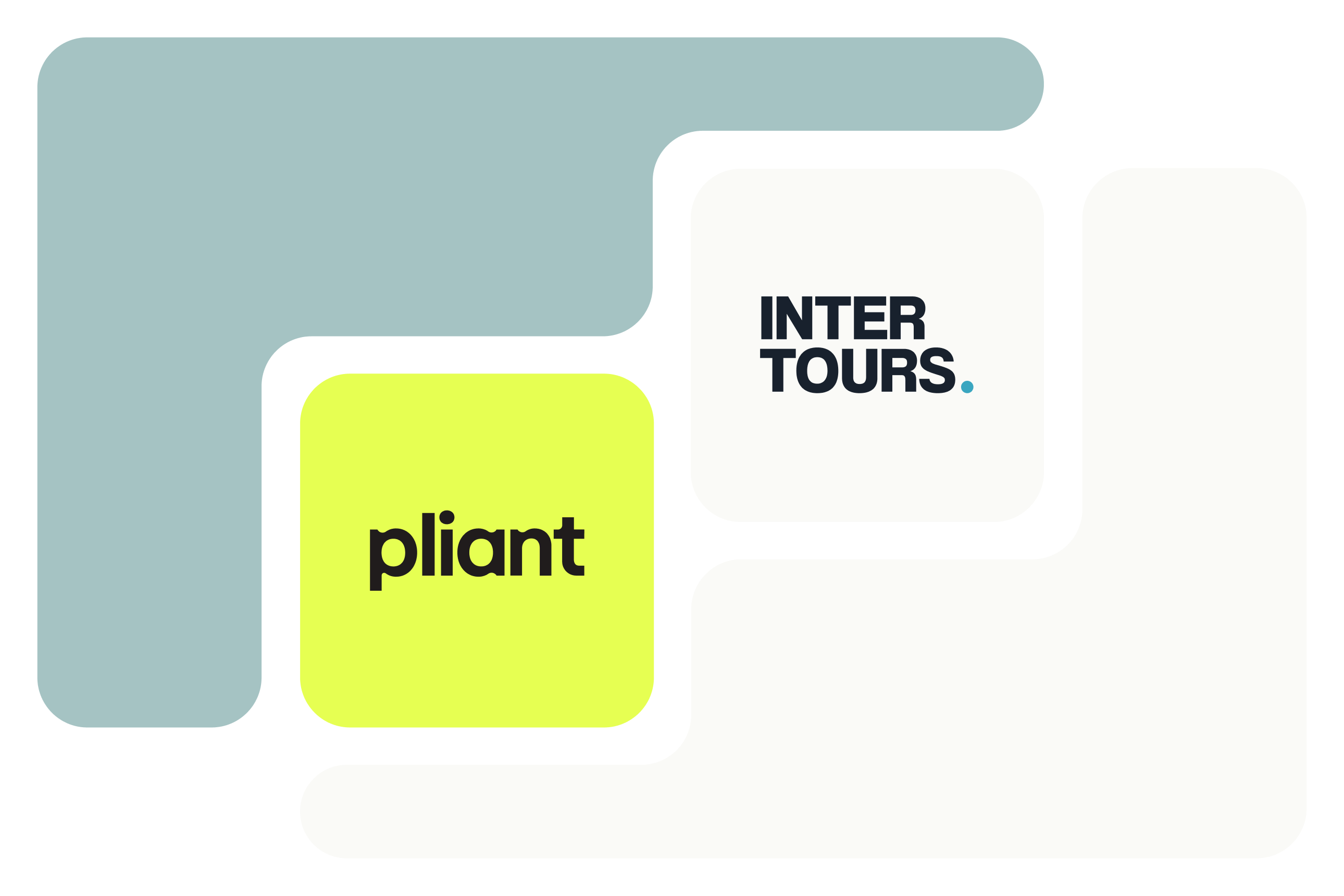
White Label Credit Cards: Is it Time to Think About an Embedded Payment Solution Instead?
If you’re looking to capitalize on the ongoing embedded finance boom, a white label credit card is likely near the top of your wishlist. However, there's more than one way to expand your horizons – and grow your profit margins – by adding a payment solution to your products and services. In fact, the big question is probably one you haven’t thought of yet: do you need a white label credit card or an embedded payment solution?
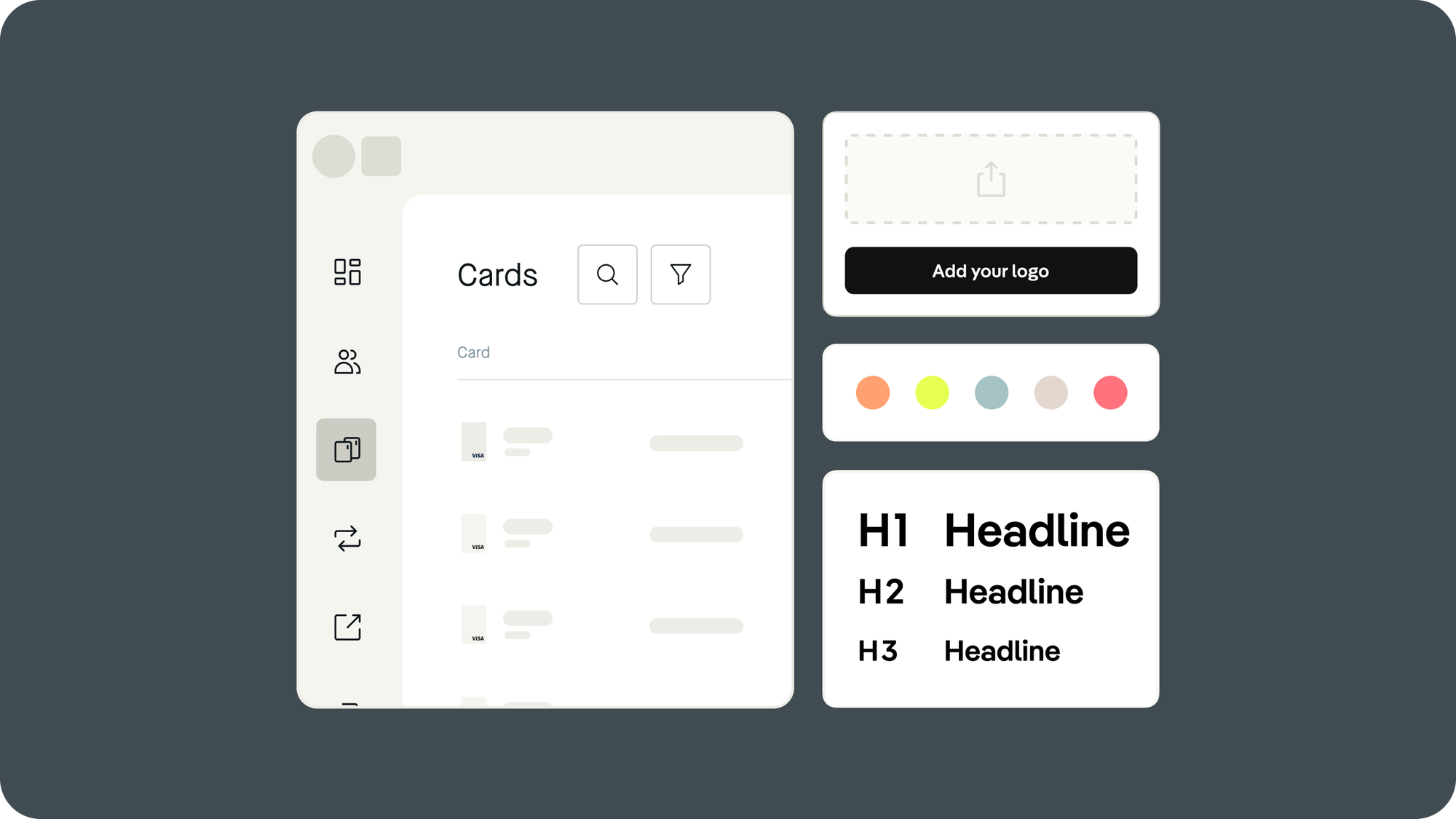
How to Launch a Credit Card: 5 Steps to Starting Your Card Program
They call it “the future of finance” – the ability of non-financial companies to offer financial products and maximize their profits – and a popular way to make the most of the embedded finance boom is to launch a credit card. It’s a big step, but starting the journey to a credit card program is simpler than you think. So, how do you launch a credit card? And is it a worthwhile step for your company?
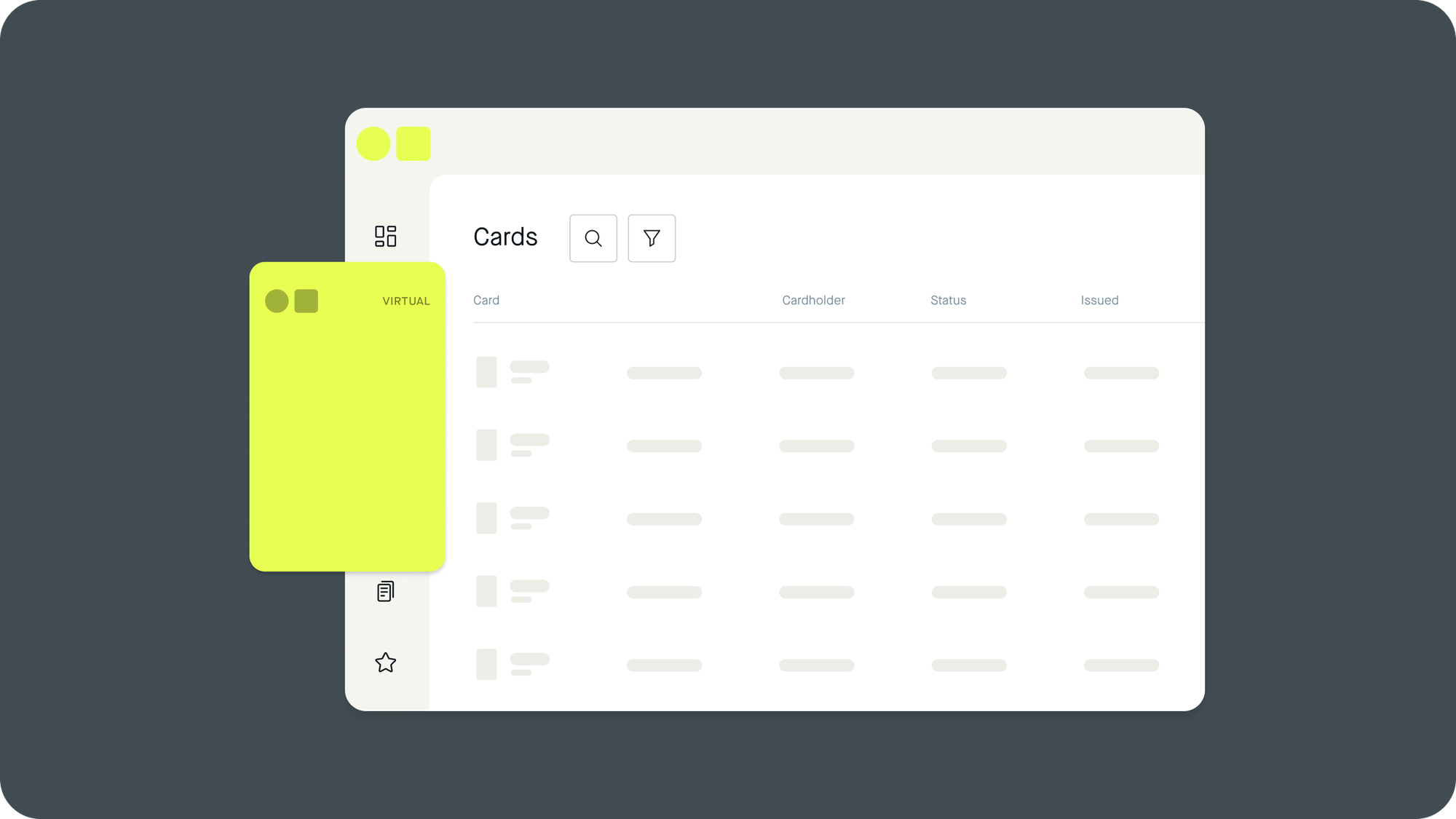
Implementing a Design System into Pliant: Enhancing Product Consistency, Scalability, and Flexibility
Hello, I'm Niko, the Principal Product Designer at Pliant. In my role, I spearhead the product design, constantly striving to elevate our product to the next level. My primary focus is on ensuring that our product remains scalable, flexible, and consistent, key qualities that are essential in the rapidly evolving tech landscape.
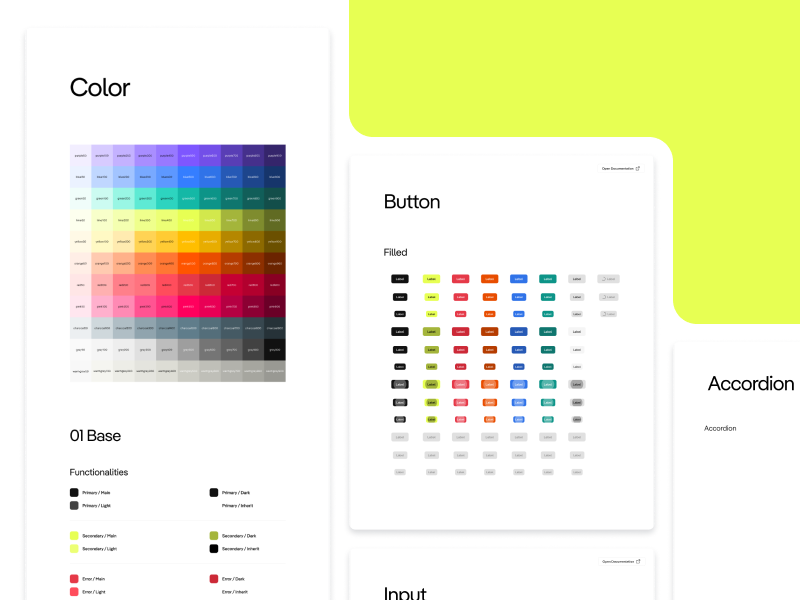

Team Evaluations: The Most Efficient Way to Evaluate Your Tour Guides
Surprisingly few companies do regular team evaluations (hopping on a tour, watching their guides, then going over the results with the them afterward)..
Prefer to listen & watch? This article has a video version.
And I get why. It takes time and resources to properly run team evaluations.
However, when you inevitably need to create some sort of hierarchy (who gets booked for tours first, for example) the criteria tend to be based on things that have less to do with the actual customer experience and more to do with operations.
The one I see most often is prioritizing guides who have the most flexible availability.
I am not a fan of this system for a few reasons.
First, a guide’s flexibility has nothing to do with their quality.
If your most flexible guide is your least amazing guide, why would you want to reward them with more tours?
Second, a subjective preference system can create frustration amongst guides.
Doing regular team evaluations is the easiest way to do a true quality check of your experiences.
To do it properly, you need to be clear on what makes your brand unique, and how that should be executed by your guides. In this article, I’ll share the criteria I use most often when running team evaluations and give some tips on how to evaluate without stressing your guides out.
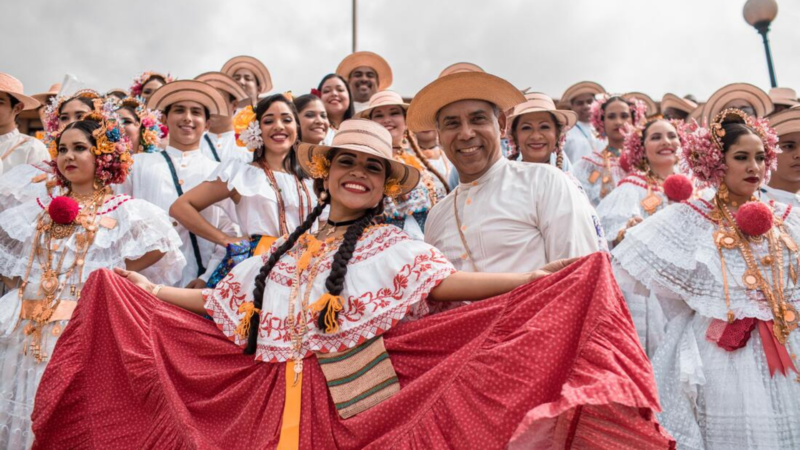
Share this article
Criteria i use most often on guide evaluations..
I like to have a check-off list separated into three sections;
- before the tour
- during the tour
- after the tour.
Each item on the list should be communicated ahead of time to guides so they know what’s expected of them & what they’re being evaluated on.
When I run the evaluation (I recommend doing it yearly), guides will get one point for each item checked off the list.
That way, if you need to list guides hierarchically in the future, you have a ‘score’.
Any items not checked off can then be discussed with the guide directly (ideally in a one-on-one meeting with their manager). Keep in mind that this is for guides you’ve already hired so it’s less about, ‘are they a good guide’ (hopefully you haven’t hired a bad one…) and more about, ‘are they executing a tour that represents our brand & is consistent with tours our other guides are doing.’
1. Brand points.
These are things taken from the brand & company values, distilled into practical things. Typically I offer 1 point per item checked off so that, should guides need to be listed hierarchically for something, you have a score all ready.
For example; (for the tours that are all about connecting you with ‘local culture’)
- Taught guests how to say ‘hello’ in the local language
- Gave at least one personal recommendation of a local shop or restaurant to visit
(for small-group tours that offer more access to your tour guide)
- Chatted one-on-one with each guest at least once during the tour
(for the tours that make you feel completely taken care of)
- Offered guests individual directions at the end of the tour
- Checked-in with guests halfway through the tour to see if expectations were being met
(for tours that pride themselves on highly-qualified guides)
- Gave their credentials in their introductions (e.g. their education, or their passion for a particular topic)
2. Company expectations .
These are the things guides are simply expected to do as employees (and should be made very clear during onboarding).
For example;
- Is wearing at least two pieces of branded gear
- Arrived at the meeting point at least 15min before the tour start
- Sent a post-tour email
- Talks about the company in their tour introduction
- Has a 50% review-ratio*
*Normally I steer away from things a guide doesn’t have 100% control over, however, if you give your guides proper training on how to achieve a 5-star review , I think it’s a non-subjective number you can include in their evaluation.
3. Objective guide skills.
These are the results of good guiding skills. Each guide is different and might have a different style or approach, but the effect should be the same. The description is a bit general, but it should be clear to guides what each means & you should offer training/resources on how to achieve each of these.
- The tour has a clear, and interesting theme
- The tour has a clear and impactful ending
- The tour is interactive
- The tour has at least one surprise ‘wow’ moment
Related articles:

The Secret to Being an Excellent Tour Guide: Mastering the Invisible Skills

How to Create Responsible Tours Even When Your Guests Take Buses and Planes.
Evaluate your guides without stressing them out..
Very few of us perform well when our manager is looking over our shoulder… Here are some ways you can put them at ease so that they can be their best.
1. Make it about the brand.
Assure your guides that you hired them for a reason and that you’re happy with their work (this is where reviews come in handy, even if I’m not a huge fan of using reviews alone for evaluation). Instead, make this about brand consistency across tours.
Explain to your team the importance of brand consistency, especially when you have a diverse guide team (more especially when you have multiple destinations). The check-list should not be personal, it should be about the ‘brand points’ being hit on every single tour.
2. Make it about the tour.
There are multiple benefits of regularly hopping on your own tours, so you can make this about evaluating the tour as opposed to the guide.
Bring the guide in on it ahead of time, letting them know that you’re there to make sure the tour content still feels fresh and that the route is the most efficient.
You can even schedule time with them afterward (buy them a tea or a beer- it goes a long way!) to get their feedback on the tour that they know so well.
Would they cut anything? Have they started to include any material that should be included in the tour training?
3. Make it about the guests.
Going on your tours is an amazingly free way to do market research . Maybe you’re ALSO evaluating the guides but you can let them know that your main purpose here is to talk to guests.
Again, bring the guides in on it. Ask them if they have any thoughts on guests’ reaction to the tours, to the content, if they’d change anything.
4. Use a mystery shopper.
If you just really don’t have the time, it’s very easy to outsource your team evaluations.
There are many companies that offer professional Mystery Shopping (and I’m always available for helping you create your own branded guide evaluations in addition to doing the mystery shopping), however, it doesn’t have to be an expensive solution.
If your evaluation check-list is easy enough to understand for a layperson, you can offer to friends and family to join the tour if they fill out an evaluation.
If you have multiple destinations, you can offer free tours for employees, including tour guides (something that’s been really successful for me when trying to create brand consistency across tours) with the requirement that they fill out an evaluation form (other guides are often guides’ toughest critics).
Was this article useful?
Once a month I send out any new articles + travel news I’m following.
- PRO Courses Guides New Tech Help Pro Expert Videos About wikiHow Pro Upgrade Sign In
- EDIT Edit this Article
- EXPLORE Tech Help Pro About Us Random Article Quizzes Request a New Article Community Dashboard This Or That Game Popular Categories Arts and Entertainment Artwork Books Movies Computers and Electronics Computers Phone Skills Technology Hacks Health Men's Health Mental Health Women's Health Relationships Dating Love Relationship Issues Hobbies and Crafts Crafts Drawing Games Education & Communication Communication Skills Personal Development Studying Personal Care and Style Fashion Hair Care Personal Hygiene Youth Personal Care School Stuff Dating All Categories Arts and Entertainment Finance and Business Home and Garden Relationship Quizzes Cars & Other Vehicles Food and Entertaining Personal Care and Style Sports and Fitness Computers and Electronics Health Pets and Animals Travel Education & Communication Hobbies and Crafts Philosophy and Religion Work World Family Life Holidays and Traditions Relationships Youth
- Browse Articles
- Learn Something New
- Quizzes Hot
- This Or That Game
- Train Your Brain
- Explore More
- Support wikiHow
- About wikiHow
- Log in / Sign up
- Education and Communications
- Official Writing
- Report Writing
How to Write a Visit Report
Last Updated: March 30, 2024 References
This article was co-authored by Madison Boehm . Madison Boehm is a Business Advisor and the Co-Founder of Jaxson Maximus, a men’s salon and custom clothiers based in southern Florida. She specializes in business development, operations, and finance. Additionally, she has experience in the salon, clothing, and retail sectors. Madison holds a BBA in Entrepreneurship and Marketing from The University of Houston. This article has been viewed 663,264 times.
Whether you’re a student or a professional, a visit report helps you document the procedures and processes at an industrial or corporate location. These reports are fairly straightforward. Describe the site first and explain what you did while you were there. If required, reflect on what you learned during your visit. No additional research or information is needed.
Writing a Visit Report
Explain the site's purpose, operations, and what happened during the visit. Identify the site's strengths and weaknesses, along with your recommendations for improvement. Include relevant photos or diagrams to supplement your report.
Describing the Site

- Reports are usually only 2-3 pages long, but in some cases, these reports may be much longer.
- In some cases, you may be asked to give recommendations or opinions about the site. In other cases, you will be asked only to describe the site.
- Ask your boss or instructor for models of other visit reports. If you can't get a model, look up samples online.

- If you visited a factory, explain what it is producing and what equipment it uses.
- If you visited a construction site, describe what is being constructed and how far along the construction is. You should also describe the terrain of the site and the layout.
- If you’re visiting a business, describe what the business does. State which department or part of the business you visited.
- If you’re visiting a school, identify which grades they teach. Note how many students attend the school. Name the teachers whose classes you observed.

- Who did you talk to? What did they tell you?
- What did you see at the site?
- What events took place? Did you attend a seminar, Q&A session, or interview?
- Did you see any demonstrations of equipment or techniques?

- For example, at a car factory, describe whether the cars are made by robots or humans. Describe each step of the assembly line.
- If you're visiting a business, talk about different departments within the business. Describe their corporate structure and identify what programs they use to conduct their business.
Reflecting on Your Visit

- Is there something you didn’t realize before that you learned while at the site?
- Who at the site provided helpful information?
- What was your favorite part of the visit and why?

- For example, you might state that the factory uses the latest technology but point out that employees need more training to work with the new equipment.
- If there was anything important left out of the visit, state what it was. For example, maybe you were hoping to see the main factory floor or to talk to the manager.

- Tailor your recommendations to the organization or institution that owns the site. What is practical and reasonable for them to do to improve their site?
- Be specific. Don’t just say they need to improve infrastructure. State what type of equipment they need or give advice on how to improve employee morale.
Formatting Your Report

- If you are following a certain style guideline, like APA or Chicago style, make sure to format the title page according to the rules of the handbook.

- Don’t just say “the visit was interesting” or “I was bored.” Be specific when describing what you learned or saw.

Sample Visit Report

Community Q&A
You Might Also Like

- ↑ http://services.unimelb.edu.au/__data/assets/pdf_file/0010/471286/Site_Reports_for_Engineers_Update_051112.pdf
- ↑ https://www.examples.com/business/visit-report.html
- ↑ https://www.thepensters.com/blog/industrial-visit-report-writing/
- ↑ https://eclass.aueb.gr/modules/document/file.php/ME342/Report%20Drafting.pdf
About This Article

To write a visit report, start by including a general introduction that tells your audience where and when you visited, who your contact was, and how you got there. Once you have the introduction written out, take 1 to 2 paragraphs to describe the purpose of the site you visited, including details like the size and layout. If you visited a business, talk about what the business does and describe any specific departments you went to. Then, summarize what happened during your visit in chronological order. Make sure to include people you met and what they told you. Toward the end of your report, reflect on your visit by identifying any strengths and weaknesses in how the site operates and provide any recommendations for improvement. For more help, including how to format your report, read on! Did this summary help you? Yes No
- Send fan mail to authors
Reader Success Stories
Betty Tarutia
Jul 9, 2020
Did this article help you?

Jayani Rathnayake
Aug 6, 2019
Jun 13, 2019
Atremedaki Phawa
Aug 19, 2019

Featured Articles

Trending Articles

Watch Articles

- Terms of Use
- Privacy Policy
- Do Not Sell or Share My Info
- Not Selling Info
Don’t miss out! Sign up for
wikiHow’s newsletter
English Compositions
Report Writing on Educational Tour [With PDF]
In this article you are going to learn how to write a report on Educational Tour organize by your school. So with out much delay let’s jump in.

Educational Tour From School
By Ashlyn Tony
February 23, 2018; Karnataka: A bright morning, our tutor came in and announced we are going for a field trip. We were excited but most of us didn’t know what was a field trip and what was the motive behind it. We packed ourselves and led ourselves to our school bus.
During the ride, our tutor explained to us what a field trip was and why it was conducted. We went to a zoological park. It was a different experience from classroom learning. We students grasped the concept much faster. The method of learning through experience was different. We could learn things outside textbooks.
This is done so that students can look into a particular topic from all possible perspectives enabling them to learn everything. It has also been proved that field trips are an excellent way for incorporating knowledge into young minds. This also helps students to learn and understand topics on their own without further explanations.
They help indirect learning and help students in finding things by themselves which is better than spoon-feeding information. This experience helps students to retain in their memories what they have learnt for a much longer period.
Field Trip To A Butterfly Garden
By Rachel Harris
January 1, 2019; New Delhi: A field trip to a nearby butterfly garden was arranged for the kindergarten students. They were all excited about the idea of visiting a butterfly garden. We took the school bus to the garden. The students were so excited to see different types of butterflies.
Students observed different varieties and their teachers helped them understand the different features. They studied the different stages of growth. They saw a huge variety of butterflies. The students were so excited. By the end, students started recognising the different varieties of butterflies. They learnt all they could about Butterflies.
Also, they used this experience for instilling in students the importance of nature. They understood that the reason behind why they could not see butterflies like before is because of the disturbances humans create in the environment.
They were also taught the importance of trees in nature. They pledged that they would not hurt mother nature and will prevent unnecessary cutting of trees. Thus, the field trip was successful.
College Field Trip
By Saira Rajput
March 2, 2016; Bombay: We students were looking forward to the field trips. We were eagerly waiting for the days to come. We had pre-planned everything. Every single detail was planned and everything was set. We were visiting places with magnificent architectural designs.
The different varieties of ideas used made us think about the brilliance of the architecture. The designs, mural paintings, the statues, and the engraving on the walls. For some of us, this was the first experience. We learned about things that one should think about before planning and executing architectural designs.
This trip also taught us about the importance of precision in planning a design. One should be able to foresee everything before starting the actual construction. The quality of the materials, the materials used and also how much is the design applicable in a particular place.
Since some materials cannot be used in some climatic conditions, one should take utmost care in selecting materials for the construction. The trip made us realise our potential and also the importance of planning and precision in our field.
Field Trip To A Cow Farm
By Mark Anthony
September 5, 2015; Gujarat: This field trip was planned so as to make students understand how a farm works. On reaching the farm, students saw a large number of cows, of different varieties. One could see the huge machines used for milking the cows. The farm had a large number of workers. There was a veterinarian for weekly checkups.
There were employees cleaning the farms. There were separate employees for each pair of cows. Cows at this farm were given high-protein foods. The sheds were cleaned regularly to control diseases that might affect the cows. One could see the care given to the cows by looking at them. After the milking process, they are sent to a nearby plant for pasteurization and packaging.
There are special sheds for pregnant cows so as to give them special care. The calves are very well taken care of. The students could understand the importance of cleanliness and regular checkups. This experience made the students realise something new and made them learn new things.
There You Have It
So you have seen the example reports on Educational Tour, I hope these examples indeed help you.
Do let me know if you have any other topic ideas that you want me to cover by leaving a quick comment just below the article.
Effortless booking
Maximize online conversions with the most intuitive checkout online.
Expand revenue with our powerful Automated E-commerce tools.
Upgrade your website to industry’s best. Fresh websites. Fresh revenue.
Amplify visibility and expand earnings with integrated OTAs and local partners.
Streamline check-ins, limit risk, and amplify customer data with built-in digital waivers.
Transform data into insights. X-ray reporting gives you customer and business intelligence.
Manage high-volume walk-up customers effortlessly with POS, ticketing, and gated entry.
Automate management of staff schedules, assignments, and staff communications
Control your business precisely the way you want with endless yet easy configurability.
Allocate equipment used in various products. Prevent overbookings and maximize profits.
Grow with Xola in our constantly expanding universe of integrations and apps.
Harness customer data to drive marketing campaigns and generate repeat business.
Transform your guests into passionate brand advocates. Perfect your products & services.
Manage your business with the most powerful mobile suite in the industry.
Perfect the guest experience by giving your staff the industry’s most intuitive software.
Efficiently manage guest flow, minimize wait times, and ensure maximum satisfaction.
Ticketing & Entry
Revolutionize your guest experience: Effortless check-ins, interactive displays, secure payments.
Boost revenue with automated rave reviews, actionable insights, and loyal customer engagement.
Efficient ticketing, digital waivers, and fast check-ins enhance on-site operations and guest satisfaction.
Explore Xola Universe: 80+ apps, limitless integrations, endless growth opportunities.
Simplify check-in and boost your marketing efforts with our integrated automated digital waivers.
With SOC 2 Type II and CCPA compliance Xola exceeds industry security standards and insures your data protection.
Access real-time insights for business growth with our powerful reporting.
Remarkable and hassle-free guest experiences with waitlist and virtual queuing.

The 3 Factors That Will Increase Your Ranking on Tripadvisor
- Xola University
- Business Operations
How to create a revenue report for your tour company (Plus revenue report templates)

Keeping track of your revenue activity on a consistent basis can help you reach your financial goals — especially if you develop the practice of sharing these reports with the rest of your company. This ensures that everyone is on the same page and allows each department to make better decisions based on that data.
In this post, you’ll find several revenue report templates to help you stay on top of your bookings on a daily, weekly, monthly, and quarterly basis.
What is a revenue report template?
A revenue report template is a report or dashboard that helps you summarize your tour business’s revenue activity over a specific period of time.
The most common revenue reports include the Profit and Loss Statement, also known as the Income Statement, Balance Sheet, and Cash Flow Statement. A revenue report template will provide you with a blueprint to create each of these.
It’ll tell you what metrics to input so that the report can be made.
How often should you prepare a revenue report?
Pulling daily, weekly, monthly, or quarterly revenue reports helps you understand how your business is operating on a short- and long-term basis.
These reports reveal valuable insights into the financial health of your business. If you spend a few months without analyzing your finances, you risk losing track of important metrics that keep your company afloat.
Small businesses can benefit from looking at their Cash Flow Statement on a weekly or monthly basis. Your cash flow is the money coming in and out of your business based on the day a booking was made.
Tours and attractions should also track realized earnings, which happen once the tour or experience is complete.
Since you likely have monthly expenses like rent, it’s helpful to understand the money that comes in and out each month.
What metrics should be included in a revenue report?
The Profit and Loss Statement typically tracks four core financial metrics: income, expenses, cost of goods sold, and net income.
- Income: The money received by your tour business or attraction
- Expense: The expenses associated with running your business, including overhead and sales and marketing costs
- Cost of Sales: The cost associated with delivering a service
- Net Profit: The amount of money your business makes after deducting the cost of sales and expenses from income
The Balance Sheet tracks what your company owns and owes. It specifically looks at your company’s assets, liabilities, and shareholder equity.
- Assets: Everything your tour business or attraction owns like vehicles, equipment, building(s), etc.
- Liabilities: Everything you owe, such as a small business loan or credit card debt
- Shareholder Equity: Everything you and other shareholders of your company have invested in the business
The Cash Flow Statement gives you a snapshot of the money coming in and out of your business. This includes money received from bookings or ticket sales, investing, and financing.
In addition, these three business metrics can give you a good idea of your company’s performance:
- Sales Revenue: All the income your company has made through tour bookings or ticket sales, excluding the cost associated with refunds or chargebacks.
- Net Profit Margin: How much profit is generated as a percentage of the revenue received. Your Net Profit margin highlights how much of each revenue dollar collected by your company actually translates into profit.
- Gross Margin: The amount of money your company keeps after the direct costs associated with providing the services you provide.
- Sales Growth: Monitor your sales growth monthly or yearly to identify the pace at which your company’s sales revenue is increasing or decreasing.
- Cost of Customer Acquisition: How much it costs your company — typically in marketing expenses — to acquire a new guest.
Daily revenue report template example

Source: Free Report Template
If you run a tour business or small attraction, you’re likely tracking your bookings or ticket sales on a daily basis. A daily revenue report shows you a summary of all your company’s transactions broken down by day.
Weekly revenue report template example
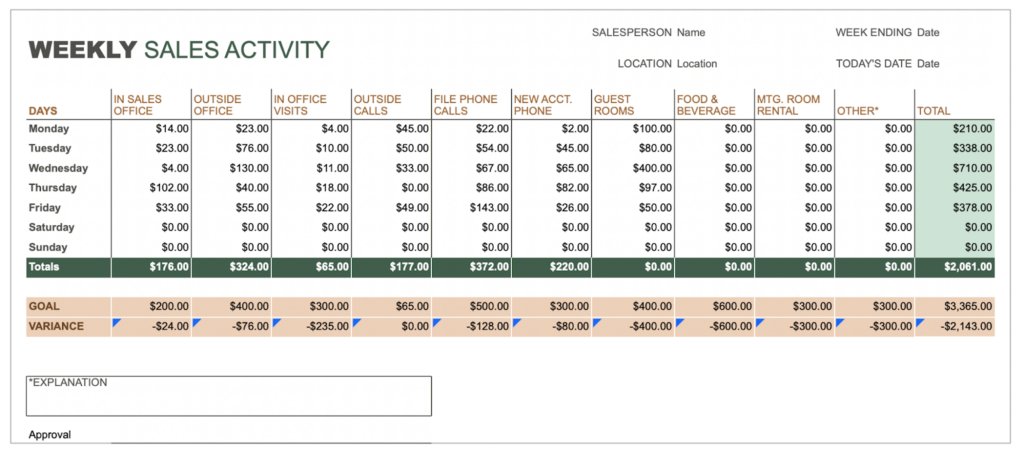
Source: Microsoft Office Templates
You can use a sales report to keep track of bookings on a weekly basis. The template above specifically tracks sales revenue against a goal.
First, edit the columns to match your business’s revenue metrics, such as in-person bookings, online bookings, third-party bookings. Then, you plug in the numbers. By the end of the week, you’ll have a complete sales activity report to present to your team.
Monthly revenue report template example
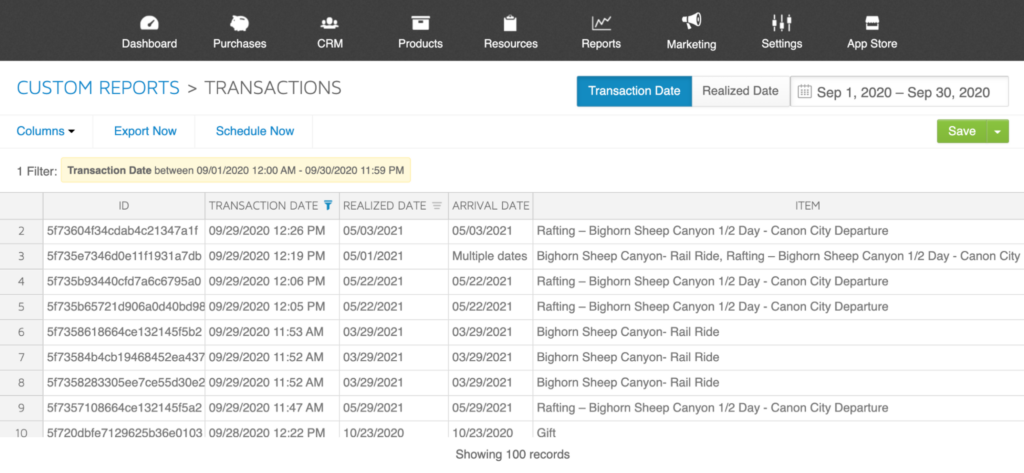
Xola’s transaction report contains financial details for every charge or refund associated with your bookings.
You can view your transactions for any date range. In this example, the report is showing the transactions made during the month of September 2020.
After viewing this report in the Xola dashboard, you can then export it into a spreadsheet.
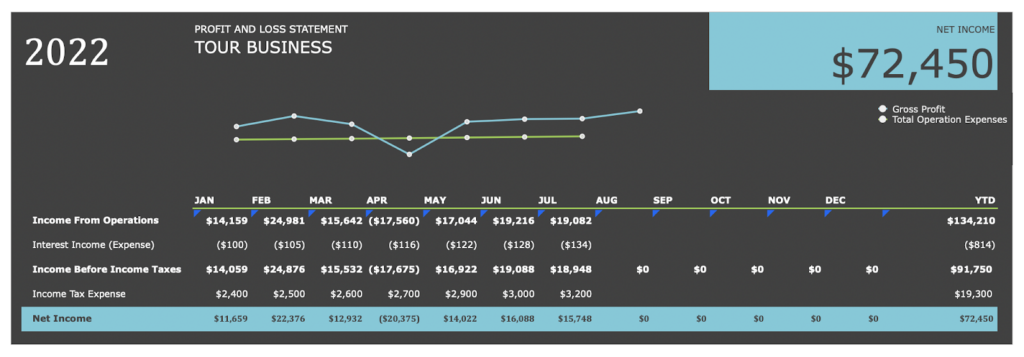
Here’s a look at a Profit and Loss Statement broken down by month. As you’ll see in the report above, the business records the income for its operations every month, as well as its expenses.
You’ll also find the net income at the bottom, or the amount your business makes after deducting costs of services provided, operating expenses, interests, and taxes.
The net income is a good indicator of your company’s profitability. Tracking this metric every month helps you understand how much of a profit your company will make over a year.
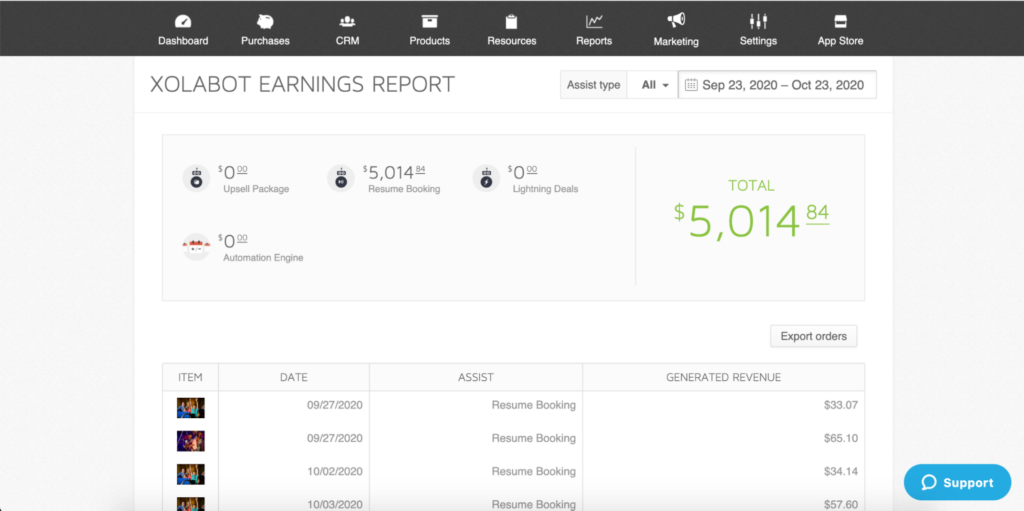
You can also pull monthly reports to see how specific marketing tools and campaigns are performing. In the example above, a monthly earnings report was pulled for Xolabot, an automatic growth feature used to upsell experiences, offer deals, and rescue abandoned bookings.
The report shows that Xolabot brought in over $5,000 with the “resume booking” feature that reminds customers to complete their purchase.
Quarterly revenue report template example
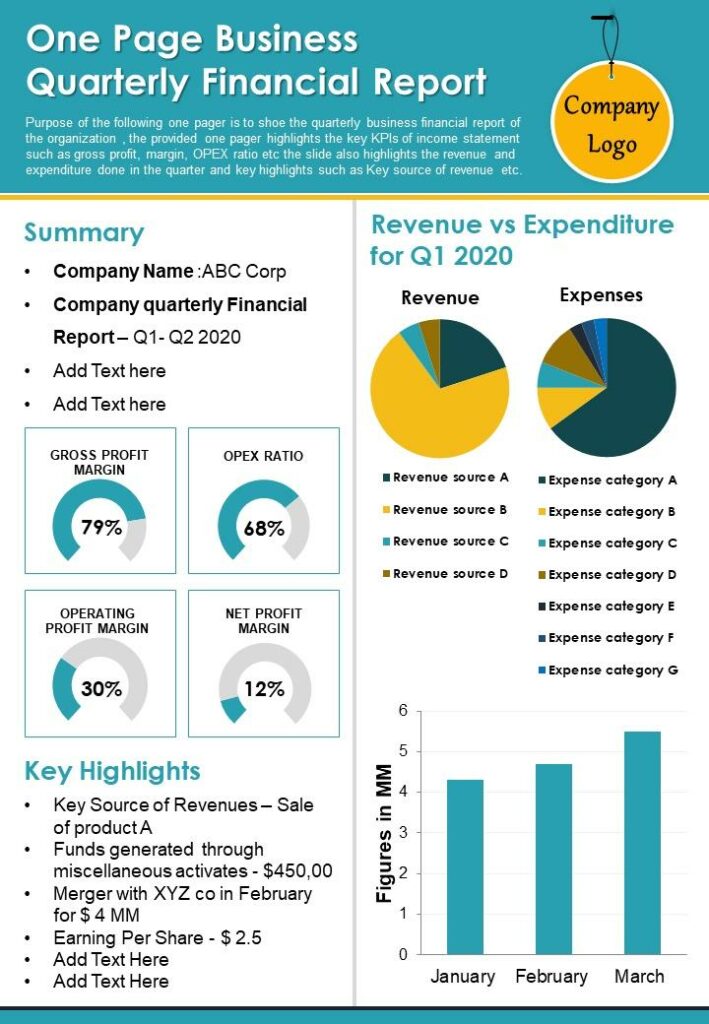
Source: Slide Team Blog
A quarterly report gives you a three-month snapshot of your financial activities. This revenue report template zeroes in on a few key metrics like gross profit margin and net profit margin — both of which help you accurately track your company’s profitability. It also takes it a step further and compares your revenue versus expenses.
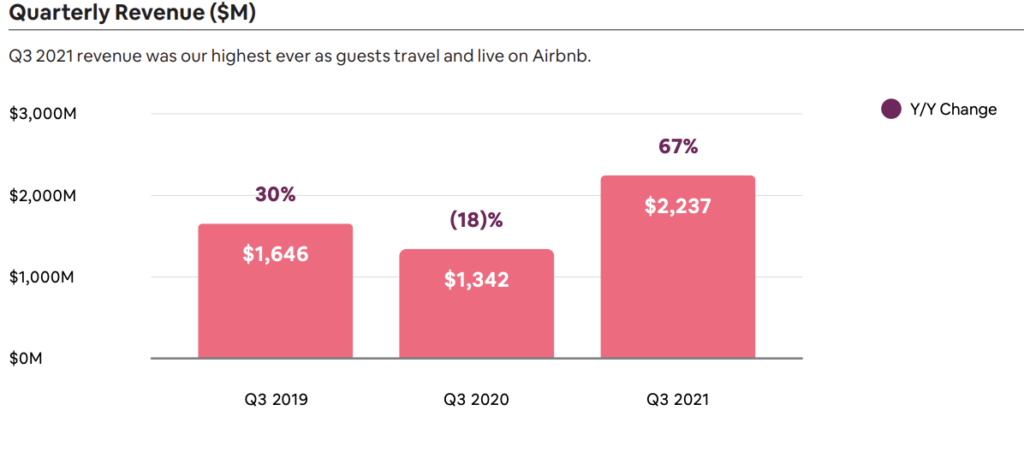
Source: Prophet Invest
As with most revenue reports, quarterly reports can be customized to display the data that matters most to your company. They can be used to track company revenue growth, as shown in the Airbnb example above.
Airbnb’s upward trajectory from Q3 2019 to Q3 2021 shows that people are traveling again, and that the service is gaining popularity in post-pandemic travel.
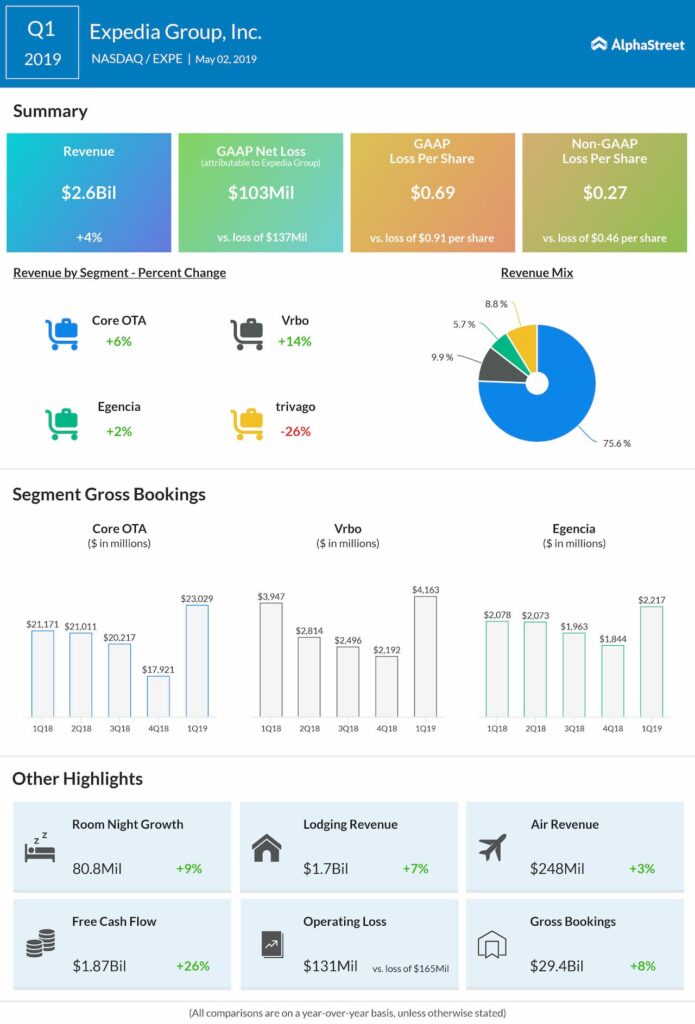
Quarterly reports can also break down your revenue by segment, as shown in this example for Expedia Group. The Online Travel Agency’s (OTA) revenue is broken down by the different brands it owns, like Vrbo and Trivago.
This gives the company a snapshot of which brands are performing best over time.

Source: GeekWire
Quarterly reports are also useful to observe historical revenue growth. In the example of Expedia shown above, the online booking marketplace displays its overall earnings broken down by quarter from 2013 to 2018.
This way, the company can compare its quarterly performance over the course of several years.
When you track your quarterly earnings, you can also make a report like this to view your company’s financial history over time.
Staying on top of your finances is the best way to ensure your profitability. And revenue reporting is the best way to do that.
The examples shown in this post can be easily used as templates to build your own reports — all you need to do is change the labels and metrics to fit your business.
Building revenue reports is even easier with a booking software like Xola, which allows you to automate the process. Xola gives you access to several financial reports so that you always have your company’s revenue data at your fingertips.
Writer Carla Vianna
Related Articles

13 Tips To Be a Better Tour Guide
Being a tour guide is a fun, exciting, and rewarding job. You spend your days sharing your knowledge and chatting

How to calculate capacity utilization
Is your attraction operating at its full design capacity potential? Key performance indicators, like your capacity utilization metric can help
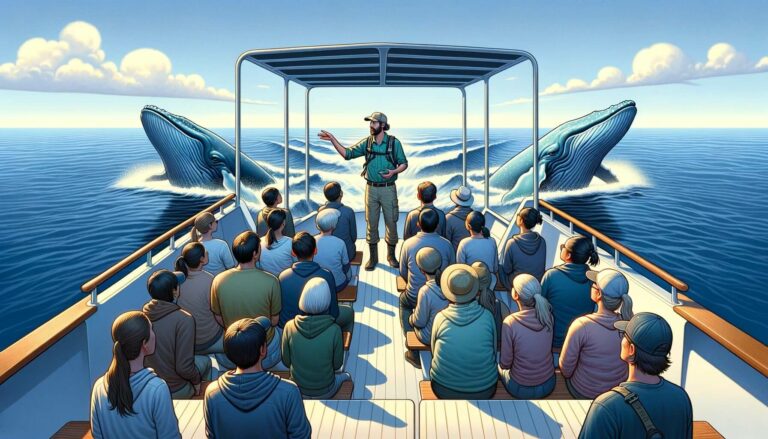
7 Skills That All Great Tour Guides Possess
When your business is growing, the thought of hiring, vetting, and managing tour guides can be daunting. In an earlier
Get the latest news and resources.
For tours and attractions delivered straight to your inbox each week.
Transform your business now.

Professional Tour Guide Cover Letter Examples for 2024
Your tour guide cover letter must immediately capture the reader's attention. Use the first paragraph to highlight your passion for cultural storytelling and your expertise in local history. In the second paragraph, emphasize your exceptional communication skills and your ability to provide engaging experiences. Remember, your cover letter is a personal introduction, so convey your enthusiasm for sharing knowledge with others.
Cover Letter Guide
Tour Guide Cover Letter Sample
Cover Letter Format
Cover Letter Salutation
Cover Letter Introduction
Cover Letter Body
Cover Letter Closing
No Experience Tour Guide Cover Letter
Key Takeaways

Navigating the competitive landscape of the tourism industry means you're ready to put your best foot forward, and a standout tour guide cover letter could be the key. While your resume lists your experience, your cover letter is your chance to share the journey behind your proudest professional milestone—without echoes of clichés or unnecessary length. Now is the time to craft a narrative that captivates within the formal confines of a page, ensuring your application embarks on the right voyage.
- Personalize your tour guide cover letter and get inspired by other professionals to tell a compelling story;
- Format and design your tour guide cover letter to make an excellent first impression;
- Introduce your best achievement in your tour guide cover letter to recruiters;
- How to make sure recruiters get in touch with you, using your tour guide cover letter greeting and closing paragraphs.
What is more, did you know that Enhancv's AI can write your cover letter for you? Just upload your tour guide resume and get ready to forward your job application in a flash.
If the tour guide isn't exactly the one you're looking for we have a plethora of cover letter examples for jobs like this one:
- Tour Guide resume guide and example
- Tour Manager cover letter example
- Summer Camp Counselor cover letter example
- Tour Director cover letter example
- Sports cover letter example
- Fitness Manager cover letter example
- Athletic Director cover letter example
- Gym cover letter example
- Event Planner cover letter example
- Event Project Manager cover letter example
- Basketball Coach cover letter example
Tour Guide cover letter example
ZOE THOMPSON
San Antonio, Texas
+1-(234)-555-1234
- Emphasize pertinent work experience: The cover letter highlights a prior role where the candidate increased sales and developed new products, demonstrating direct experience in developing and expanding tourism services.
- Highlight partnerships and negotiation skills: Mentioning partnerships with local vendors not only showcases the ability to work collaboratively but also underscores the candidate's negotiation skills which are crucial in coordinating tour packages and enhancing the client experience.
- Demonstrate alignment with company values: Showing awareness of the company's ethos and tailoring the cover letter to match that vision can effectively connect the candidate's personal objectives with the potential employer's mission.
- Showcase community involvement: Detailing the initiative to boost community tourism underlines a commitment to sustainable practices and community development, which is often an important aspect of the tourism industry.
The must-have sections and format of your tour guide cover letter
When writing your tour guide cover letter, keep in mind that it'll only be read by the recruiters and not the Applicant Tracker System (or software used to assess your profile). That's why you should structure your content with a/an:
- Header (apart from your contact information, include your name, the role you're applying for, and the date);
- Personalized salutation;
- Opening paragraph to win the recruiters over;
- Middle paragraph with key details;
- Closing that starts from clichés;
- Sign off (that's not mandatory).
Industry standards dictate your paragraphs to be single-spaced and to wrap your content in a one-inch margin. Designing your tour guide cover letter, refer to one of our templates , which automatically takes care of the spacing and margins.
Choose the same font for your tour guide cover letter as you did for your resume : the likes of Lato and Bitter would help you to stand out in a sea of cover letters in Arial or Times New Roman.
Export your whole tour guide cover letter from our builder in PDF to keep the same formatting and image quality.
The top sections on a tour guide cover letter
- Header: Include your contact information, the date, and the employer's details for a professional layout and to ensure the recruiter can easily reach out to you.
- Greeting: A personalized greeting to the hiring manager shows that you've done your research and are genuinely interested in the company you're hoping to guide tours for.
- Introduction: In this section, provide a captivating opener that includes your enthusiasm for the role and a brief mention of your most relevant experience as a guide, to immediately engage the reader.
- Body: Here, delve into specific anecdotes demonstrating your storytelling skills, knowledge of the locale, and your ability to engage and manage groups, which are crucial for a tour guide position.
- Closing: End with a strong conclusion reiterating your passion for guiding and cultural exchange, and include a call-to-action such as the willingness to discuss your qualifications further, which creates an opening for interview opportunities.
Key qualities recruiters search for in a candidate’s cover letter
- Exceptional communication skills: Tour guides interact with diverse groups and must be able to convey information clearly, engagingly, and effectively.
- Extensive knowledge of the tour area: Recruiters look for candidates who are well-versed in the history, geography, culture, and attractions of the locations they will be guiding.
- Customer service orientation: Providing a memorable and enjoyable experience is crucial, and a tour guide must be attentive to the needs and preferences of each guest.
- Language proficiency: For tours in multilingual regions or with international travelers, being fluent in more than one language is highly beneficial.
- Charismatic and outgoing personality: A tour guide should be able to captivate an audience and make the tour memorable with their enthusiasm and energy.
- Problem-solving abilities: Guides must be able to think on their feet and handle unexpected issues, such as changes in weather, itinerary alterations, or guest inquiries.
Greeting recruiters with your tour guide cover letter salutation
What better way to start your conversation with the hiring manager, than by greeting them?
Take the time to find out who the professional, recruiting for the role, is.
Search on LinkedIn, the company website. And for those still keen on making a fantastic first impression, you could even contact the organization, asking for the recruiter's name and more details about the job.
Address recruiters in the tour guide greeting by either their first name or last name. (e.g. "Dear Anthony" or "Dear Ms. Smarts").
If you're unable to discover the recruiter's name - don't go for the impersonal "To whom it may concern", but instead use "Dear HR team".
List of salutations you can use
- Dear Hiring Manager,
- Dear [Employer's Name],
- Dear [Employer's Title] [Last Name],
- Dear [Department] Team,
- Dear [Company Name] Recruiter,
- Good Day [Employer's Name],
Introducing your profile to catch recruiters' attention in no more than two sentences
The introduction of your tour guide cover letter is a whole Catch 22 .
You have an allocated space of no more than just a paragraph (of up to two sentences). With your introduction, you have to stand out and show why you're the best candidate out there.
Set out on a journey with your tour guide cover letter by focusing on why you're passionate about the job. Match your personal skills and interests to the role.
Another option for your tour guide cover letter introduction is to show you're the ideal candidate. Write about how your achievements and skills are precisely what the company is looking for.
However you decide to start your tour guide cover letter, always remember to write about the value you'd bring about. Making it both tangible (with your metrics of success) and highly sought out.
What comes next: your tour guide cover letter middle paragraphs
In the next three to six paragraphs (or the body of your tour guide cover letter) you have to prove your unique value .
Most candidates tend to mess up at this stage. They tend to just copy-paste information from their resume.
That's one big no-no.
Remember that when writing your tour guide cover letter, it has to be personalized. And, your ultimate aim is to catch the recruiter's eye.
So, look back on key job requirements and write down a list that includes the ones you cover.
Next, select just one key achievement from your professional (or personal) history that meets those advert keywords.
Narrate a story around how you've grown your skill set and knowledge. Also, aim to show the unique understanding or soft skills you bring about, thanks to your past success.
Closing remarks to end your tour guide cover letter
Of course, you'll have to show gratitude to the recruiters, who have assessed your profile at the end of your tour guide cover letter .
A "Thank you for the consideration" would work wonders, instead of the standard "Sincerely yours".
Do you want to make an even better impression?
Close off your tour guide cover letter by promising how you see yourself excelling in the role and the positive impact you'd bring about.
A sentence that encourages some further action on the recruiter's end could also be a good way to close off the communication (e.g. provide your availability for an interview).
Keep this in mind when writing your zero experience tour guide cover letter
Even though you may not have any professional experience , your tour guide cover letter should focus on your value.
As a candidate for the particular role, what sort of skills do you bring about? Perhaps you're an apt leader and communicator, or have the ability to analyze situations from different perspectives.
Select one key achievement from your life, outside work, and narrate a story that sells your abilities in the best light.
If you really can't think of any relevant success, you could also paint the picture of how you see your professional future developing in the next five years, as part of the company.
Key takeaways
We hope this tour guide cover letter writing guide has shown you how to:
- Format your tour guide cover letter with the mandatory sections (e.g. header, greeting, intro, body, and closing) and select the right font (P.S. It should be the same as the one you've used for your resume);
- Substitute your lack of professional experience with your most noteworthy achievement, outside of work, or your dreams and passions;
- Ensure recruiters have a more personalized experience by tailoring your cover letter not just to the role, but to them (e.g. writing their first/last name in the salutation, etc.);
- Introducing your biggest achievement and the skills it has taught you in your tour guide cover letter body;
- Write no more than two sentences in your tour guide cover letter introduction to set the right tone from the get-go.

Cover letter examples by industry

AI cover letter writer, powered by ChatGPT
Enhancv harnesses the capabilities of ChatGPT to provide a streamlined interface designed specifically focused on composing a compelling cover letter without the hassle of thinking about formatting and wording.
- Content tailored to the job posting you're applying for
- ChatGPT model specifically trained by Enhancv
- Lightning-fast responses

How To Follow Up on a Job Application
The best resume structure: examples, templates & tips, can i leave a job i was fired from off my resume, stay or go: navigating the gray area of quitting a new job, how to answer: "what's your biggest weakness" in an interview, how do left-brainers and right-brainers organize their new year’s resolutions.
- Create Resume
- Terms of Service
- Privacy Policy
- Cookie Preferences
- Resume Examples
- Resume Templates
- AI Resume Builder
- Resume Summary Generator
- Resume Formats
- Resume Checker
- Resume Skills
- How to Write a Resume
- Modern Resume Templates
- Simple Resume Templates
- Cover Letter Builder
- Cover Letter Examples
- Cover Letter Templates
- Cover Letter Formats
- How to Write a Cover Letter
- Resume Guides
- Cover Letter Guides
- Job Interview Guides
- Job Interview Questions
- Career Resources
- Meet our customers
- Career resources
- English (UK)
- French (FR)
- German (DE)
- Spanish (ES)
- Swedish (SE)
© 2024 . All rights reserved.
Made with love by people who care.

An official website of the United States government
Here’s how you know
Official websites use .gov A .gov website belongs to an official government organization in the United States.
Secure .gov websites use HTTPS A lock ( Lock Locked padlock icon ) or https:// means you’ve safely connected to the .gov website. Share sensitive information only on official, secure websites.

International travel documents for children
See what documents a child needs to travel to or from the U.S. alone or with a parent or relative.
Children traveling to the U.S.
All children, including infants, must have their own travel documents such as a passport or document from a Trusted Traveler Program to enter the U.S. If you travel or are going to travel with a child, consider taking the following documents:
- If the child is traveling with only one of their custodial parents, they must have a letter of consent, preferably in English and notarized, from the other parent or signed by both parents. The letter should say "I acknowledge that my son/daughter is traveling outside the country with [the name of the adult] with my permission."
- If one parent has sole custody of the child, a copy of the custody document can take the place of the other parent's letter.
- Parents who frequently cross the border by land with a minor must always carry a letter of permission from the other parent.
U.S. citizen children traveling abroad
Ports of entry in many countries have security measures to prevent international child abduction . If you are traveling alone with your child, you may be required to present documentation proving you are the parent or legal guardian. You may also need a letter of permission from the other parent for your child to travel.
If your child travels alone, depending on the country, they may be required to present a notarized letter from both parents or their legal guardian. If a minor is traveling abroad and is not accompanied by both parents or a legal guardian, contact the embassy or consulate of the country you will be visiting and ask about entry and exit requirements for that country.
LAST UPDATED: December 6, 2023
Have a question?
Ask a real person any government-related question for free. They will get you the answer or let you know where to find it.
Security Alert May 17, 2024
Worldwide caution, update may 10, 2024, information for u.s. citizens in the middle east.
- Travel Advisories |
- Contact Us |
- MyTravelGov |
Find U.S. Embassies & Consulates
Travel.state.gov, congressional liaison, special issuance agency, u.s. passports, international travel, intercountry adoption, international parental child abduction, records and authentications, popular links, travel advisories, mytravelgov, stay connected, legal resources, legal information, info for u.s. law enforcement, replace or certify documents.
Reports and Statistics
Create a MyTravelGov Account
Share this page:
MyTravelGov provides a modernized platform where you can submit and check on requests to the Bureau of Consular Affairs. To get started, create MyTravelGov account. With an account, you can apply for an electronic Consular Report of Birth Abroad (CRBA) in most countries.
Video: How to Create a MyTravelGov Account
Follow the steps in the video to setup your account today!
External Link
You are about to leave travel.state.gov for an external website that is not maintained by the U.S. Department of State.
Links to external websites are provided as a convenience and should not be construed as an endorsement by the U.S. Department of State of the views or products contained therein. If you wish to remain on travel.state.gov, click the "cancel" message.
You are about to visit:

IMAGES
VIDEO
COMMENTS
Audience analysis: Identify the demographics, interests, and knowledge level of your tour group. Tailoring content: Adjust your script to include information that resonates with these interests. Engage personally: Add personal touches or address the group in a way that makes them feel included in the narration.
Following the introduction, briefly describe the tour. Mention the destination, the duration, and the main attractions covered. This gives readers a context to understand the rest of your review. The next step is to introduce your tour guide. Write about their personality, their style of guiding, and the first impression they made.
Sample Tour Guide Speech in English. This page covers vocabulary needed by people working as tour guides in an English-speaking context. Listen to a tour guide on a shuttle bus from the airport to the resort. You can listen first, and then read. After that, test your understanding with the quick check.
In conclusion, mastering the art of script writing for tour guiding is a crucial skill for any tour guide looking to provide an exceptional experience for their guests. Throughout this blog, we have explored the various aspects of script writing and how it can greatly enhance the overall tour experience. We began by understanding the role of a ...
Guests want to head into a tour feeling confident that a guide will deliver a memorable experience. With your approach, aim to be both informative and engaging with your guests from the get-go. 2. Bookend points of interest. Lead with the most commonly asked questions and topics that are featured in your tour listing.
Gives your guide a chance to introduce themselves: A script should feature a fun introduction, allowing guests to build a personal connection with your guides right away. A confidence boost for guides: Armed with a ready-to-go script, tour guides feel more confident and prepared — which, in turn, translates into a more enjoyable delivery.
The tour guide provided us with a detailed account of the events that took place at the site, and we were able to visualize the events better. We also had the opportunity to see some of the artifacts that were recovered from the site, which added to our learning experience. ... Educational Tour Report Example #3. Educational tours are an ...
Composing Reports is quite a tough task on its own. Composing outstanding Reports is an even more pressing exercise. Composing an excellent Tour Report is, well, something superhuman. Yet, with the WePapers.com free catalog of professionally written Tour Report examples, the job is perfectly manageable. Look through our database, spot a piece ...
Tip #8: Use Small Words. When writing a tour script, the KISS principle applies. Write clear and simple. Don't use big words like pontificate or conviviality. Use words that are easily understood by your audience. Remember, your guests don't have time to reference a dictionary or thesaurus.
With captivating visuals, modern fonts, and customizable colors, this template enhances the readability and appeal of your report. It's designed to accommodate various trip purposes, industries, and functions, providing design flexibility. Change colors, fonts and more to fit your branding. Access free, built-in design assets or upload your own.
The meaning of a business trip report is to give an overview of the trip and justify the expenses. With a travel report, you tell your manager (or other relevant people in the company) what your trip was about: purpose, goals, achievements, learnings, and recommendations. The purpose of a business trip can be, for example, to solidify business ...
Explain to your team the importance of brand consistency, especially when you have a diverse guide team (more especially when you have multiple destinations). The check-list should not be personal, it should be about the 'brand points' being hit on every single tour. 2. Make it about the tour.
1. Add a title page to the beginning of your report. The title should be the name of the visit and site, such as "Visit to Airplane Factory" or "Corporate Headquarters Visit Report." Under the title, include your name, your institution, and the date of the visit. Do not put any other information on this page.
September 5, 2015; Gujarat: This field trip was planned so as to make students understand how a farm works. On reaching the farm, students saw a large number of cows, of different varieties. One could see the huge machines used for milking the cows. The farm had a large number of workers.
The template above specifically tracks sales revenue against a goal. First, edit the columns to match your business's revenue metrics, such as in-person bookings, online bookings, third-party bookings. Then, you plug in the numbers. By the end of the week, you'll have a complete sales activity report to present to your team.
3. Listen to feedback. The primary goal of giving a tour to a group of guests is for them to enjoy themselves, so receiving feedback is one of the most effective ways to improve as a guide. If your company uses feedback cards, they can provide valuable insight into your performance, as do reviews on online platforms.
A Model for Tour Guide Performance. Nour Salah Al-Okaily. Department of Tourism Management, School of Archaeology and Tourism, The University of Jordan, Amman, Jordan. ABSTRACT. Tourism literature ...
White and Blue Professional Photo Travel Instagram Post. Instagram Post by Mai Kreativ Designs. Green Creative Tour Package to Indonesia Instagram Post. Instagram Post by Stevcreative. Cream Green Vintage Summer Tour Poster. Poster by 9"IDEAS. Dark Green Clean Band Tour instagram Post. Instagram Post by Derana Studio.
Consider using professional, consistent fonts like Arial, Helvetica or Times New Roman. Keep your font sizes at around 10 and 12 points and adjust your margins to around 1 to 1.5 inches. Learn what a tour guide does and discover steps for how to write a tour guide resume with a template and example to help you complete your application.
A sample of 286 tour guides of British, Israeli, Korean, and Dutch nationalities rated 20 behavioral characteristics of American tourists on escorted motor coach tours. The objective of the study ...
This Guide, The Art of Designing and Implementing Study Tours, aims to take out the guesswork by breaking down the process into simple steps. The Study Tour Guide is written specifically for those who broker or coordinate or facilitate Study Tours between knowledge seekers and knowledge providers. A Study Tour is a learning journey for both the ...
Introducing your biggest achievement and the skills it has taught you in your tour guide cover letter body; Write no more than two sentences in your tour guide cover letter introduction to set the right tone from the get-go. Rate my article: Professional Tour Guide Cover Letter Examples for 2024. Average: 4.80 / 5.00.
To remove an item from your credit report, you can dispute it with the credit bureaus, providing evidence if necessary, and follow up until it's resolved. Alternatively, you may negotiate with the creditor directly to settle the debt in exchange for its removal from your report. According to the Federal Trade Commission, around one in five ...
The latest travel news, deals, guides and tips from the travel experts at USA TODAY. All the travel insights you need to plan your dream vacation.
Children traveling to the U.S. All children, including infants, must have their own travel documents such as a passport or document from a Trusted Traveler Program to enter the U.S. If you travel or are going to travel with a child, consider taking the following documents: If the child is traveling with only one of their custodial parents, they ...
Request a File Search. You may request a file search instead of submitting evidence of U.S. citizenship if: You got a U.S. passport or Consular Report of Birth Abroad in the past, and. You cannot submit it with your application. The file search fee is $150 and charged as part of the application fee which you pay to the U.S. Department of State.
Machine learning and deep learning are both types of AI. In short, machine learning is AI that can automatically adapt with minimal human interference. Deep learning is a subset of machine learning that uses artificial neural networks to mimic the learning process of the human brain. Take a look at these key differences before we dive in further.
MyTravelGov. MyTravelGov provides a modernized platform where you can submit and check on requests to the Bureau of Consular Affairs. To get started, create MyTravelGov account. With an account, you can apply for an electronic Consular Report of Birth Abroad (CRBA) in most countries.
The Affiliate Marketer - someone who signs directly with a product creator or an affiliate network to market their products to their online readers, viewers, or contacts. In the case of TikTok affiliate marketing, the affiliate marketer will promote the affiliate products in their TikTok videos. The Consumer - somebody who ultimately buys ...